Prepare an Actionable Roadmap for Your PMO

- Problems with project management offices (PMOs) often start with a lack of a clear definition of what the PMO is actually about and what the organization does.
- Few organizations provide the minimum required services, and many are not using their PMOs effectively. Many people see the PMO as nothing more than the “project document police,” i.e. a source of red tape rather than a helpful support system. This impacts staffing and hiring.
- The PMO is often misunderstood as a center for project management governance when it also needs to facilitate the communication of project data from project teams to decision makers to ensure that appropriate decisions get made around resourcing, approval of new projects, etc.
- Accountability is something that is not clearly defined for many activities that flow through the PMO. Business leaders, project workers, and project managers are rarely as aligned as they need to be.
Our Advice
Critical Insight
- There is a gap in the perception of the actual role of the PMO in many organizations by different stakeholder groups. Many people see the PMO as police that produce red tape rather than a helpful support system. Those that need to present a coherent plan to leadership to champion the need for a PMO often have an uphill battle.
- Determine the PMO’s role and needs and then determine your staff needs based on that PMO.
- Staff the PMO according to its actual role and needs. Don’t rush to the assumption that PMO staff starts with accomplished project managers.
- The difference in a winning PMO is determined by a roadmap or plan created at the beginning.
Impact and Result
- Define a PMO with functions that work for you based on the needs of your organization and the gaps in services. A “fit-for-purpose” PMO is the right kind of PMO for your organization.
- Determine your PMO staffing needs. Our approach to building a PMO starts by analyzing the staffing requirements of your PMO mandate.
- Create purpose-built role descriptions. Once you understand the staff and skills you’ll need to succeed, we have job description aids you’ll need to fill the roles.
Prepare an Actionable Roadmap for Your PMO Research & Tools
Besides the small introduction, subscribers and consulting clients within this management domain have access to:
1. Prepare and Actionable Roadmap for Your PMO – An actionable deck to help you establish a valuable PMO.
Before setting up or re-structuring a PMO, organizational need should not only be taken into consideration but used as a foundation. Phase 1 of this blueprint will help you define the services that your PMO should provide to your organization, instead of the one-size-fits-all approach that doesn’t work.
- Prepare an Actionable Roadmap for Your PMO – Phases 1-3
2. PMO Role Definition Tool – An Excel tool to help you define the services of your PMO.
Use the PMO Role Definition Tool to establish your PMO current state and the service gaps you may have. Use the results to determine the role your PMO should play within your organization.
- PMO Role Definition Tool
3. PMO Project Charter – A template to formalize your PMO and make sure everyone is on the same page.
The PMO Project Charter shares the vision to achieve consensus between stakeholders and projects and initiatives of the PMO. Use this template to jump-start your PMO project.
- PMO Project Charter
4. Blank Job Description Template – A template to create different job descriptions from.
Use this template to create your job descriptions from scratch.
- Blank Job Description Template
5. Portfolio Manager Job Description – A clear and realistic job description template for a Portfolio Manager.
The Portfolio Manager will oversee the business of discovering unsatisfied needs, articulating them as project demand, and organizing appropriate responses. Your customers are the people who approve projects, and you will service them.
- Portfolio Manager
6. PMO Job Description Builder Workbook – An Excel tool to help you access PMO staffing requirements.
This tool will help you assess staffing requirements to facilitate project management, business analysis, and organizational change management outcomes.
- PMO Job Description Builder Workbook
7. PMO Strategic Plan – A template to help you compose a PMO strategy.
This template will help you compose a PMO strategy. Follow the steps in the blueprint to complete the strategy.
- PMO Strategic Plan
8. Organizational Change Impact Analysis Tool – An Excel tool to analyze the impact of change to the organization.
Use the Organizational Change Impact Analysis Tool to analyze the effects of a change across the organization, and to assess the likelihood of adoption to right-size your OCM efforts.
- Organizational Change Impact Analysis Tool
9. PMO MS Project Plan – A template to map out timeline for completing the tasks to create your PMO.
Use this tool to determine the next steps and assign tasks to the appropriate people.
- PMO MS Project Plan Sample
Infographic
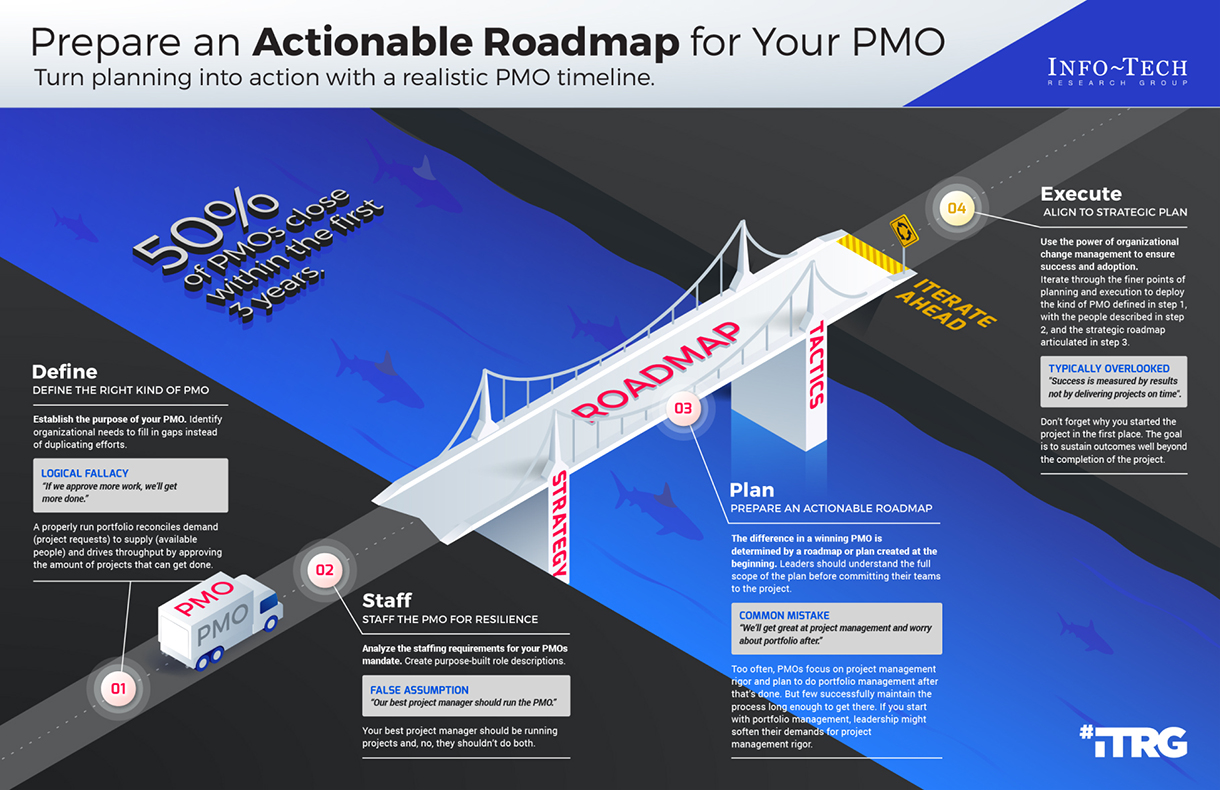
Workshop: Prepare an Actionable Roadmap for Your PMO
Workshops offer an easy way to accelerate your project. If you are unable to do the project yourself, and a Guided Implementation isn't enough, we offer low-cost delivery of our project workshops. We take you through every phase of your project and ensure that you have a roadmap in place to complete your project successfully.
1 Define
The Purpose
Get a common understanding of your PMO options.
Determine where you are and engage leadership.
Key Benefits Achieved
A clear vision for your PMO and an articulated reason for establishing it.
An understanding of you PMO goals and which challenges it sets to address.
Activities
1.1 PPM Current State Scorecard
1.2 SWOT Analysis
1.3 Current State and Leadership Engagement
1.4 PMO Mandate and Vision
Outputs
PPM Current State Scorecard Results
SWOT Results
PMO Role Development Tool
PMO Charter
2 Staff
The Purpose
Identify organizational design.
Build job descriptions.
Key Benefits Achieved
An analysis of staffing requirements of your PMO that aligns with your mandate from phase 1.
Job description aids to fill the necessary roles.
Activities
2.1 Right, Wrong, Missing, Confusing
2.2 PMO Function, Roles, and Responsibilities
2.3 Job Descriptions
Outputs
Right, Wrong, Missing, Confusing Results
Job Description Survey Tool
Job Description Templates
3 Plan
The Purpose
Create a roadmap.
Key Benefits Achieved
An actionable roadmap that can be presented to leadership and implemented.
Activities
3.1 Roadmap Hierarchy and Staffing and Sizing
3.2 Governance and Authority
Outputs
PMO Roadmap Draft
Governance Authority
4 Change
The Purpose
Set up governance and OCM.
Key Benefits Achieved
An introduction to the concept of governance and tools for a change impact analysis.
Activities
4.1 Analyze the impact of the change across multiple dimensions and stakeholder groups.
4.2 Gain sponsorship.
Outputs
Organizational Change Impact Analysis Tool
Sponsor Template
Further reading
Prepare an Actionable Roadmap for Your PMO
Turn planning into action with a realistic PMO timeline.
EXECUTIVE BRIEF
Analyst Perspective
Prepare an actionable roadmap for your PMO.

We all have junk drawers somewhere in our homes, and we probably try not to think about what’s going on in there. We’re just happy that they close and that the contents are concealed from anyone living in or passing through the house.
What goes in these junk drawers? Things that don’t have a home, things you don’t know what to do with, and things you don’t have the time or desire to deal with. Eventually, the drawer gets full, and it doesn’t serve you anymore because you can’t add anything else to it. Instead of cleaning the drawer and keeping the things you need, you throw everything away in one sweep. One day you will start the process again.
The junk drawer is like your project management office (PMO). The PMO is given projects that are barely scoped, projects that don’t have clear sponsors, and ad hoc administrative tasks you don’t have the time or desire to deal with. Inevitably, your PMO is out of capacity. This happens rather quickly, since it’s understaffed. You question its purpose because you made it a junk drawer. You even think about closing it. One day you will start the process again.
Use this blueprint to stop the madness. Learn how to properly define, staff, and plan a roadmap of a PMO that will actually serve your organization.
Ugbad Farah, PMP
Senior Research Analyst, PPM
Info-Tech Research Group
Your challenge
This research is designed to help organizations that are facing these challenges:
- No visibility into projects
- The organization views the PMO as unnecessary overhead
- The PMO is not properly staffed to support the organization’s needs
- Project managers/staff aren’t providing information or following processes
- Leadership and sponsors are disengaged
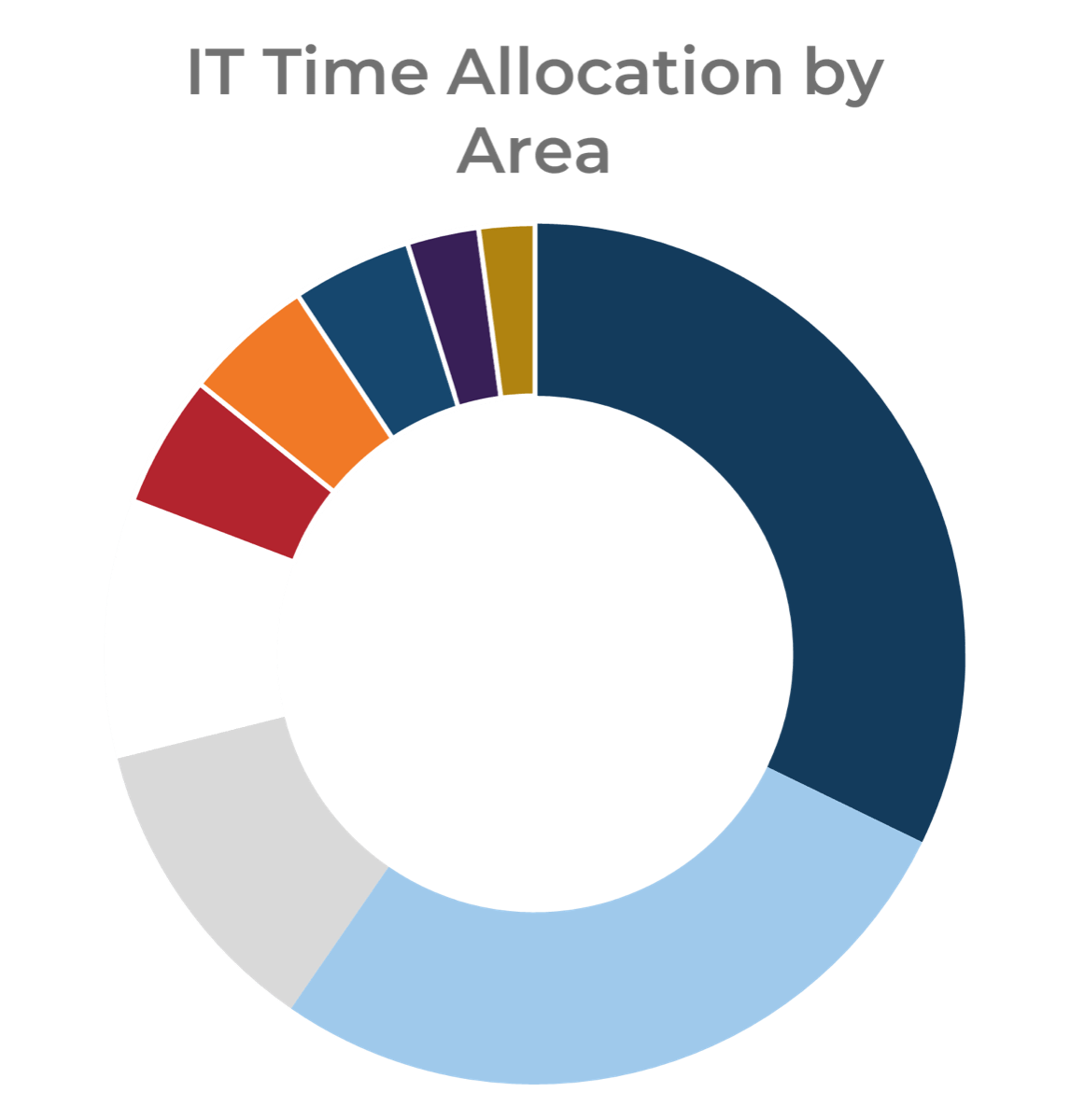
IT is responsible for many different business services. The data from Info-Tech’s IT Staffing diagnostic shows that 11.5% of staff time is spent on projects and project portfolio management. (Source: Info-Tech IT Staffing Benchmark Report)
PMOs can’t do everything and be all things to all people. Define limits with a strong mandate and effective staffing. Make sure you have the skills and capacity to support required PMO functions.
Project management chaos
PMOs get pulled into the day-to-day project and resourcing issues, making it difficult to focus on running a portfolio:
- Teammates seem unphased by overdue tasks and missed milestones.
- Fire drills may happen more often than planned projects.
- Resources are allocated and then redirected to something more urgent.
- Communication that’s stuck in silos, leading to confusion about priorities.
- Due dates mysteriously shift without explanation.
- Project teams are more focused on the due date than adoption and outcomes.
Common obstacles
IT and PMO leaders face several challenges.
- Many people see the PMO as nothing more than the “project document police,” i.e. a source of red tape rather than a helpful support system. This impacts staffing and hiring.
- The PMO is often misunderstood as a center for project management governance, when it also needs to facilitate the communication of project data from project teams to decision makers to ensure that appropriate decisions get made around resourcing, approval of new projects, etc.
- Accountability is something that is not clearly defined for many activities that flow through the PMO. Business leaders, project workers, and project managers are rarely as aligned as they need to be.
The Reality
68% — Sixty-eight percent of stakeholders see their PMOs as sources of unnecessary bureaucratic red tape. (Source: KeyedIn, 2014)
50% — Fifty percent of PMOs close within the first three years due to such things as poorly defined mandates and poor leadership. (Source: KeyedIn, 2014)
Info-Tech’s approach
Prepare an Actionable Roadmap for Your PMO
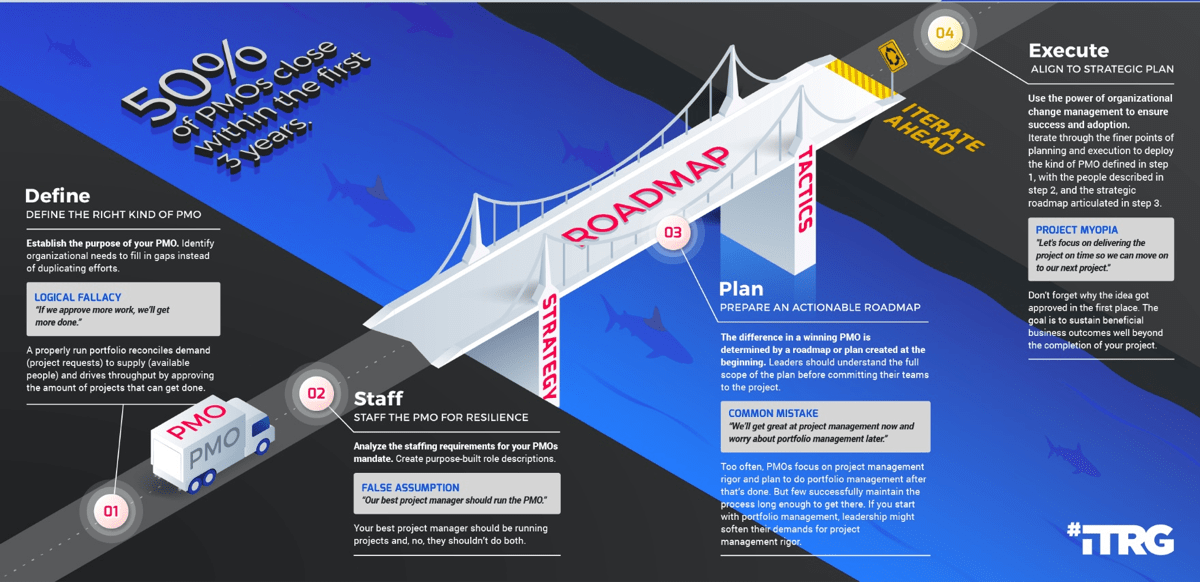
The Info-Tech difference:
- Get a departmental job description first. Defining your PMO may not be as simple as it seems. Explore the boundaries of portfolio, project, resource, and organizational change management before jumping ahead with processes and tools.
- The staffing plan should come before your long-term plan. Get buy-in around your definition of the roles needed to run your PMO before articulating a long-term plan. Too often, plans have been accepted without the commensurate level of staffing. Our approach gives you a chance to put hiring on the roadmap as a predecessor to accountability.
- Keep your eye on the ball. Build your PMO around the operational imperative to recognize completed projects as an early milestone in broader changes. In other words, projects exist to create change.
Prepare an Actionable Roadmap for your PMO
Turn planning into action with a realistic PMO timeline.
50% of PMOs close within the first 3 years.

|
|

|
|
01 DefineDEFINE THE RIGHT KIND OF PMOEstablish the purpose of your PMO. Identify organizational needs to fill in gaps instead of duplicating efforts. LOGICAL FALLACY
A properly run portfolio reconciles demand (project requests) to supply (available people) and drives throughput by approving the amount of projects that can get done. |
02 StaffSTAFF THE PMO FOR RESILIENCEAnalyze the staffing requirements for your PMOs mandate. Create purpose-built role descriptions. FALSE ASSUMPTION
Your best project manager should be running projects and, no, they shouldn't do both. |
03 PlanPREPARE AN ACTIONABLE ROADMAPThe difference in a winning PMO is determined by a roadmap or plan created at the beginning. Leaders should understand the full scope of the plan before committing their teams to the project. COMMON MISTAKE
Too often, PMOs focus on project management rigor and plan to do portfolio management after that's done. But few successfully maintain the process long enough to get there. If you start with portfolio management, leadership might soften their demands for project management rigor. |
04 ExecuteALIGN TO STRATEGIC PLANUse the power of organizational change management to ensure success and adoption. Iterate through the finer points of planning and execution to deploy the kind of PMO defined in step 1, with the people described in step 2, and the strategic roadmap articulated in step 3. PROJECT MYOPIA
Don't forget why the idea got approved in the first place. The goal is to sustain beneficial business outcomes well beyond the completion of your project. |
Info-Tech’s methodology for Preparing an Actionable Roadmap for Your PMO
| 1. Define the PMO | 2. Staff the PMO | 3. Prepare a Roadmap | |
| Phase Steps |
|
|
|
| Phase Outcomes | A clear vision for your PMO and an articulated reason for establishing it.
An understanding of your PMO goals and which challenges it sets to address. |
An analysis of staffing requirements of your PMO that aligns with your mandate from phase 1. Job descriptions help to fill the necessary roles. | An actionable roadmap that can be presented to leadership and implemented. An introduction to the concept of governance and tools for a change impact analysis. |
Insight summary
Overarching insight
There is a gap in the perception of the actual role of the PMO in many organizations by different stakeholder groups. Many people see the PMO police that produce red tape rather than a helpful support system. Those that need to present a coherent plan to leadership championing the need for a PMO often have an uphill battle.
Phase 1 insight
Determine the PMO’s role and needs and then determine your staff needs based on that PMO.
PMO leaders are all too often set up to fail, left to make successes out of PMOs that:
- have poorly defined mandates;
- lack the proper resourcing to support the services the organization requires; or
- lack executive leadership, vision, and backing.
Phase 2 insight
Staff the PMO according to its actual role and needs. Don’t rush to the assumption that PMO staff starts with accomplished project managers.
Many organizations have PMOs of one person, and it is simply not a long-term recipe for success. People in this situation have a lot of weight on their shoulders and feel like they are being set up to fail. It is very challenging for anyone to run a PMO alone without support or administrative help.
Phase 3 insight
The difference in a winning PMO is determined by a roadmap or plan created at the beginning.
When you are determining what your PMO will provide in the future, it is important to align the ambition of the PMO with the maturity of the business. Too often, a lot of effort is spent trying to convince businesses of the value of a PMO.
Blueprint deliverables
Each step of this blueprint is accompanied by supporting deliverables to help you accomplish your goals:
| PMO Role Definition Tool | 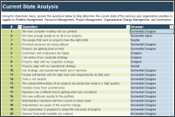
|
PMO Project Charter Template | 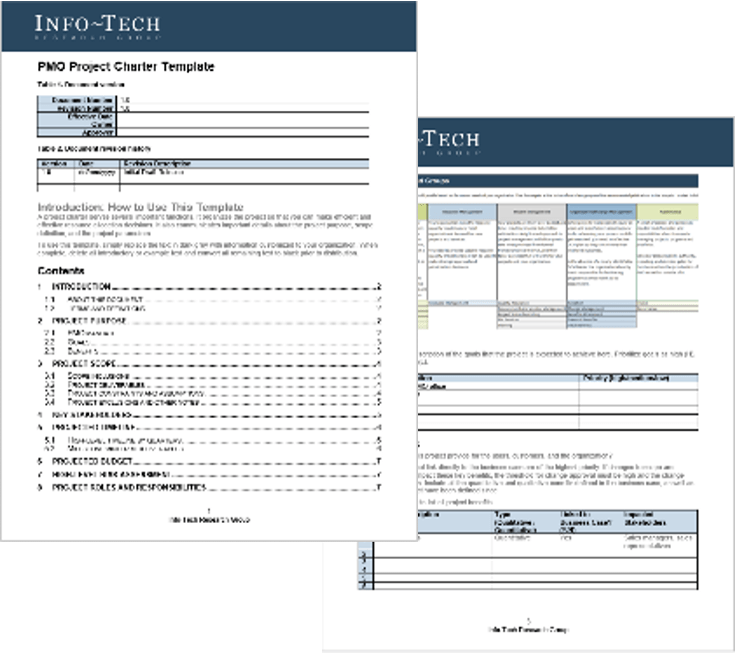
|
||
Blank Job Description Template
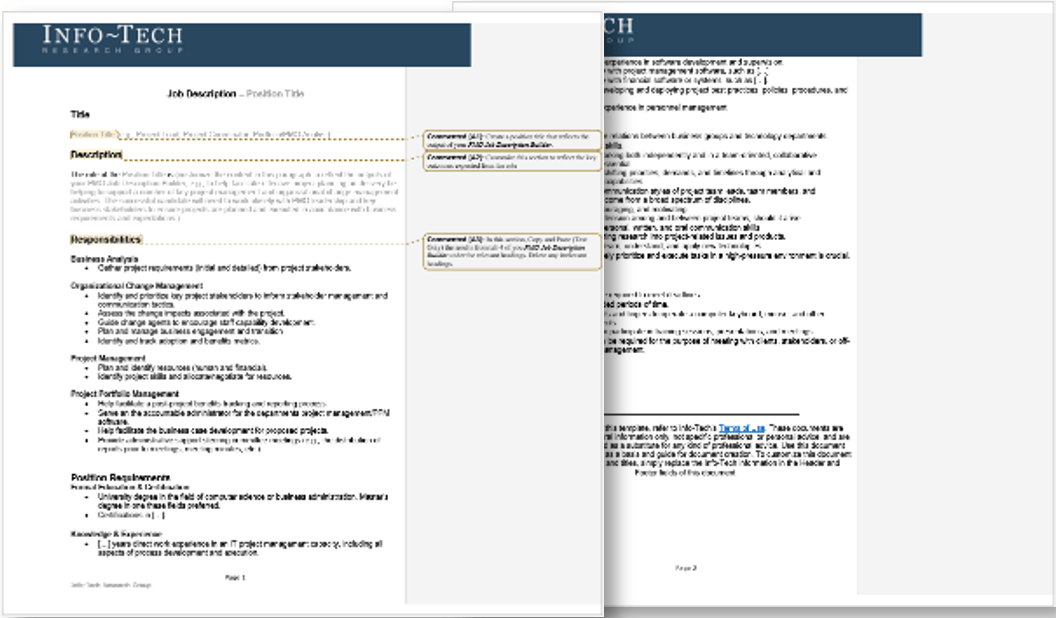
|
Sample Job Descriptions
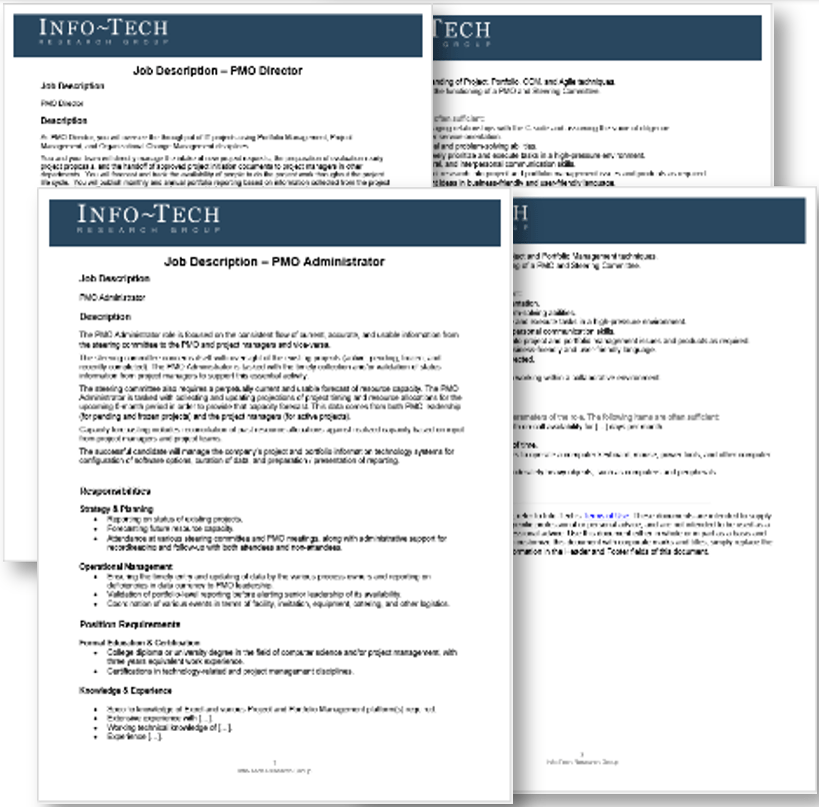
|
PMO Job Description Builder Workbook
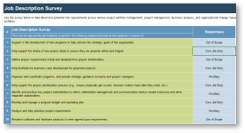
|
|||
Blueprint deliverables
Each step of this blueprint is accompanied by supporting deliverables to help you accomplish your goals:
PMO Strategic Plan
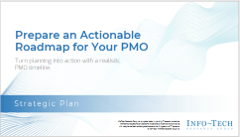
|
PMO MS Project Plan Sample
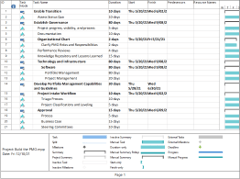
|
Organizational Change Impact Analysis Tool
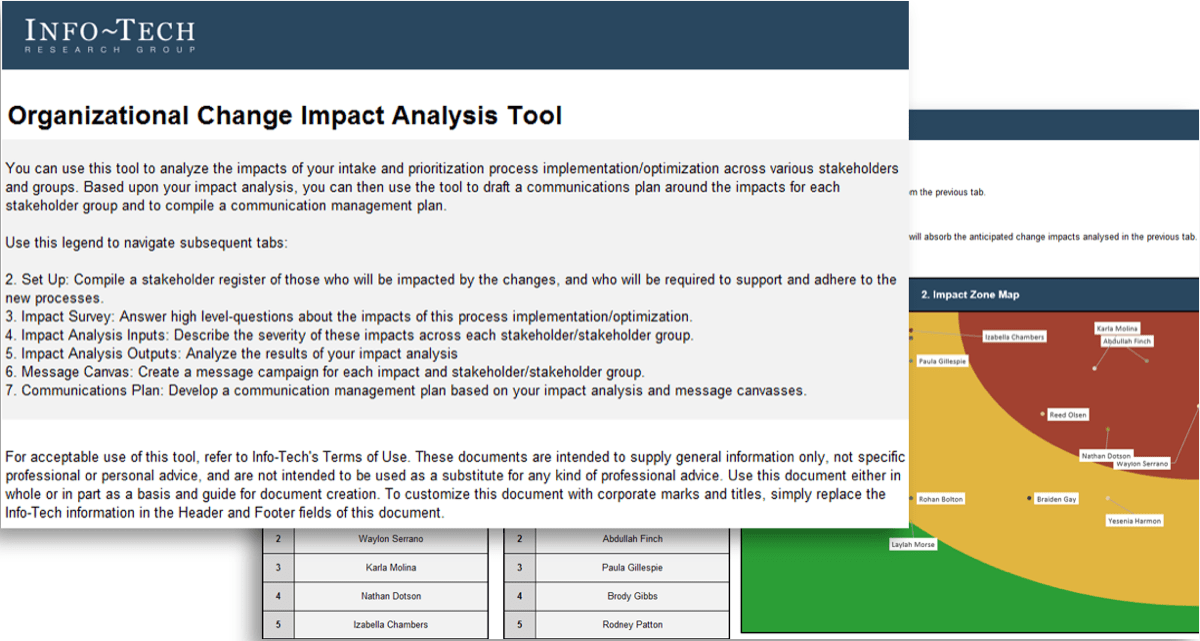
|
Benefits
IT Benefits
- Determine how you can fill gaps and not duplicate efforts to bring value to your organization.
- Ensure that key PMO capabilities like portfolio management, project management, and organizational change management are in balance.
- Staffing is purpose-driven. Avoid putting good people in the wrong role.
Business Benefits
- Intake and governance have a primary focus and are not merely afterthoughts of someone primarily focused on project management methodology.
- Avoid unrealistic commitments by ensuring better upfront analysis of ability to execute.
- Ensure appropriately mandated sponsor management.
Info-Tech offers various levels of support to best suit your needs
DIY Toolkit |
Guided Implementation |
Workshop |
Consulting |
| "Our team has already made this critical project a priority, and we have the time and capability, but some guidance along the way would be helpful." | "Our team knows that we need to fix a process, but we need assistance to determine where to focus. Some check-ins along the way would help keep us on track." | "We need to hit the ground running and get this project kicked off immediately. Our team has the ability to take this over once we get a framework and strategy in place." | "Our team does not have the time or the knowledge to take this project on. We need assistance through the entirety of this project." |
Diagnostics and consistent frameworks used throughout all four options
Guided Implementation
A Guided Implementation (GI) is a series of calls with an Info-Tech analyst to help implement our best practices in your organization.
A typical GI is 8 to 12 calls over the course of 4 to 6 months.
What does a typical GI on this topic look like?
- Call #1: Scope requirements, objectives, and your specific challenges.
- Call #2: Assess current state and determine PMO role/type.
- Call #3: Complete job description survey.
- Call #4: Analyze survey results and complete FTE analysis.
- Call #5: Discuss necessary roles and create job descriptions.
- Call #6: Discuss business goals and priorities.
- Call #7: Identify and prioritize initiatives on roadmap.
- Call #8: Discuss governance and organizational change.
- Call #9: Summarize results in strategic plan and discuss next steps.
Phase 1
Phase 2
Phase 3
Workshop Overview
Contact your account representative for more information.
workshops@infotech.com1-888-670-8889
| Day 1 | Day 2 | Day 3 | Day 4 | Day 5 | |
| Activities |
Define1.1 Review PPM Current State Scorecard Results 1.2 Get a Common Understanding of Your PMO Options 1.3 Conduct SWOT Analysis 1.4 Current State and Leadership Engagement 1.5 PMO Mandate and Vision |
Staff2.1 Identify Organizational Design 2.2 Right, Wrong, Missing, Confusing 2.3 PMO Function, Roles, and Responsibilities 2.4 Job Descriptions |
Plan3.1 Roadmap Top-Level Hierarchy 3.2 Roadmap Second-Level Hierarchy 3.2 Staffing and Sizing 3.3 Reconcile and Finalize Roadmap 3.4 Governance and Authority |
Change4.1 Importance of OCM 4.2 Sponsorship 4.3 Analyze the Impact of the Change Across Multiple Dimensions and Stakeholder Groups |
Next Steps and Wrap-Up (offsite)5.1 Complete in-progress deliverables from previous four days. 5.2 Set up review time for workshop deliverables and to discuss next steps. |
| Deliverables |
|
|
|
|
|
Prepare an Actionable Roadmap for Your PMO
Phase 1
Define the Right Kind of PMO
Phase 1
|
Phase 2
|
Phase 3
|
A PMO may not simply be an office of project managers
Project management offices are evolving and taking on activities that differ from company to company.
| 1915 | 1930s | 1950s | 1980s | 1990s |
| Frederick Taylor introduces the PMO with the implementation of the scientific management method and the increase in the number and complexity of projects. | The US Air Corps creates a Project Office function to monitor aircraft development (probably the first record of the term being used). | The US military starts developing complex missile systems. Each weapon system was composed of several sub-projects grouped together in system program offices (SPOs). This built the structures underlying the traditional PMO. | The Project Office concept exported to construction and IT. | The PMO gains a lot of momentum with professional associations and project management certifications becoming recognized industry standards. |
Organizations are confused about what a PMO is, whether they should have one, and what it should do
PMBOK
The responsibilities of a PMO can range from providing project management support functions to the direct management of one or more projects. The PMO is an organizational body assigned with various responsibilities related to the centralized and coordinated management of those projects under its domain.
The PMO may play a role in supporting strategic alignment and delivering organizational value, integrating data and information for organizational strategic projects, and evaluating how higher-level strategic objectives are being fulfilled.
COBIT
The PMO can be responsible for portfolio maintenance, setting a standard approach for project and program and portfolio management.
OPM
The PMO is an organizational body assigned with various responsibilities related to the centralized and coordinated management of those projects under its domain.
In an effort to set a standard, the governance frameworks have over complicated it for most of us.
Use Info-Tech’s framework to create the PMO that works for your organization
|
Determine the Services Your PMO Will Provide
Establish Your PMO’s Mandate
Ensure Organizational Needs Are Being Met
|
Hierarchy of PMO Needs
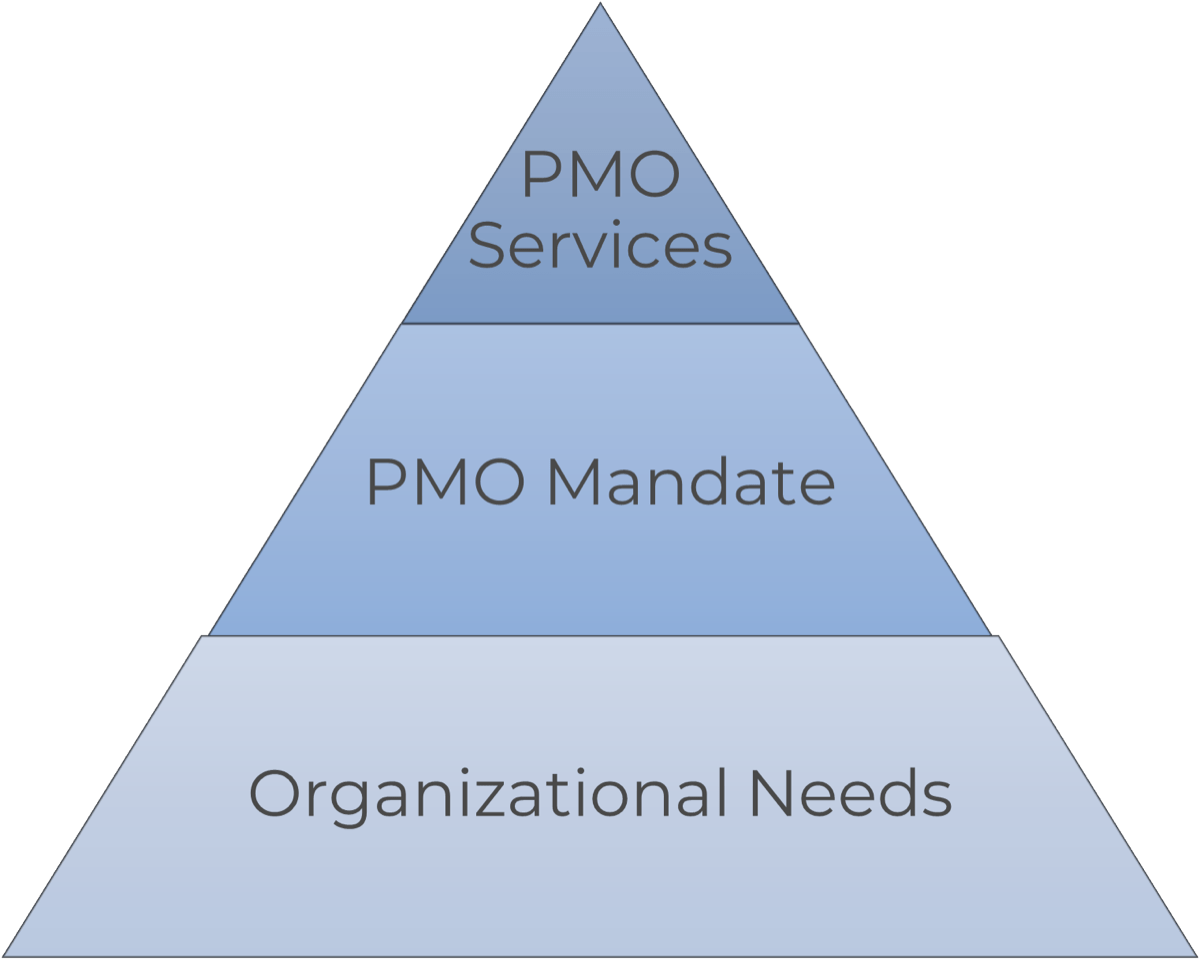
|
Info-Tech Insight
Consider the principles of Maslow’s Hierarchy of Needs, which view the lower tiers of the hierarchy as fundamentally required to validate the pursuit of the higher tiers.
Step 1.1
Get a Common Understanding of Your PMO Options
Activities
- 1.1.1 Review PMO Types
- 1.1.2 SWOT Analysis
This step will walk you through the following activities:
- Review Info-Tech’s PMO Types
- Complete a Strengths, Weaknesses, Opportunities, and Threats Analysis
This step involves the following participants:
- PMO director and/or portfolio manager
- PMO staff/stakeholders
- Project managers
Outcomes of this step
- Current state analysis
| Step 1.1 | Step 1.2 |
People mistake the PMO as only an office with project managers
It sounded simple enough, but no one could really explain what it meant.
PMOs are often born out of necessity or desperation. A traumatic event happens, and leadership decides that it wouldn’t have happened had there been a “Project Management Office.” The phrase itself is often quite reassuring and offers the hope of some sort of sanity and order.
People may not really be able to explain what a PMO is, but they do have a common understanding that it should solve all project management issues. But simply prescribing the “PMO” as a remedy for every organizational alignment is not going to be sufficient. There are different types of PMOs and more importantly there are different types of organizations.
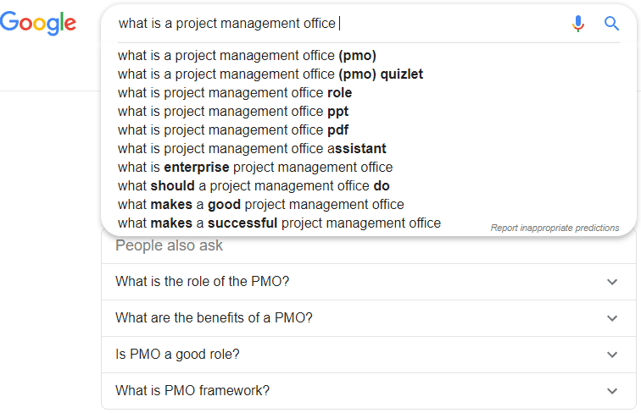
Google and the Google logo are trademarks of Google LLC.
The PMI has described what a PMO could be
The PMI does not have a standard for PMOs like it does for things like project, program, and portfolio management. Its PMO definitions should be used as more of a reference point than a best practice.
But what should it do?
- Supportive: Provides a consultative role to projects by supplying templates, best practices, training, access to information, and lessons learned from previous projects.
- Controlling: Provides support and requires compliance through various means.
- Directive: Takes control of the projects by directly executing them.
The PMI described three types of PMOs. These three types are well known in the industry, but they are essentially characteristics and do little to help people understand the functions and services of a PMO. There continue to be questions about the role a PMO should play in an organization and how it’s supposed to add value.

Thousands of practitioners came together at the 2012 PMI Symposium and expanded upon PMBOK’s PMO types
- Managing
Manages the work in projects and programs. - Consulting
Serves as an experience-based consultative body to project managers. - Project Repository
Repository of previous project documentation, lessons learned, etc. - Enterprise PMO
Provides PMO services to the organization. - Center of Excellence
Creates the standard and methodologies and provides tools. - Managerial
Manages the project and program managers, and eventually, other project resources. - Delivery
Manages the project and programs.
1.1.1 Leverage Info-Tech’s PMO types to anchor yourself
We have narrowed it down to five types of PMOs.
| ePMO |
IT PMO |
PMO |
CMO |
CoE |
| Enterprise
Highest level PMO, typically responsible to align project and program work to strategy-significant projects or programs for the entire organization. Could include both IT and business units. |
IT
IT PMOs provide project-related support for IT project portfolios. For many organizations PMOs originate in IT departments because of the structure required for technology-related projects. |
Project/Program
Provides project-related tactical service as an entity to support a specific project or program. Can be dismantled when program is done. |
Change
Change management offices (CMO) help build change management capabilities and enable change readiness in organizations. |
Excellence
These centers differ in size and mode of organization, depending on their subject and scope. They support project work by providing the organizations with standard methodologies and tools. |
What is your definition of a PMO?
Use this model to clearly show what is in and out of scope.
| ePMO | IT PMO | PMO | CMO | CoE | ||
| PPM | Reporting for enterprise portfolio and the financial/human resources needed to deliver them | X | ||||
| PPM | Finance for project/portfolio capital and expense | X | X | |||
| PPM | Customer Management – the customers, sponsors of the project | X | X | |||
| PPM | Strategy Management – projects and programs relate to corporate | X | X | X | ||
| PPM | Program Management – related projects in the portfolio | X | X | X | ||
| PPM | Time Accounting | X | X | x | ||
| PPM | Business Relationship Management (BRM) | X | X | |||
| PPM | Project Information System (PMIS) – organization of project information | X | X | |||
| PPM | Administrative Support – general assistance with Portfolio | X | ||||
| PPM | Record Keeping – Enterprise Information | X | X | |||
| RM | Forecasting | X | ||||
| PM | Quality Assurance | X | X | |||
| PM | Procurement and Vendor Management | X | X | X | ||
| PM | Project Status Reporting | X | X | |||
| PM | PM Services | X | X | X | ||
| PM | Training | X | ||||
| PM | PM SOP | X | ||||
| OCM | Adoption | X | X | |||
| OCM | Change Management | X | X | |||
| OCM | Benefits Attainment | X | X | |||
| OCM | Forecast Benefits | X | X | |||
| OCM | Track Benefits | X | X | |||
| GOV | Intake | X | ||||
| GOV | Governance | X | X | |||
| GOV | Reporting | X | X | X | X |
Use Info-Tech’s PMO function matrix to help provide role definitions for your PMO
Info-Tech’s potential PMO capabilities are in the header of the table below. These are the services a PMO may (or may not) provide depending on the needs of the organization.
| Portfolio Management | Resource Management | Project Management | Organizational Change Management | PMO Governance | |||
| Recordkeeping and bookkeeping | Strategy management | Assessment of available supply of people and their time | Project status reporting | PM SOP (e.g. feed the portfolio, project planning, task managing) |
Benefits management | Technology and infrastructure | |
| Reporting | Financial management | HR | Security | ||||
| PMIS | Intake | Matching supply to demand based on time, cost, scope, and skill set requirements | Procurement and vendor management | Legal | Financial | ||
| CRM/RM/BRM | Program management | ||||||
| Tracking of utilization based on the allocations | Quality | Intake | |||||
| Time Accounting | PM services (e.g. staffing project managers or coordinators) |
Quality assurance | Organizational change management | Project progress, visibility, and process | |||
| Forecasting of utilization via supply-demand reconciliation | Closure and lessons learned | ||||||
| Administrative support | PM Training | ||||||
The rest of this blueprint will help you choose the right capabilities and accompanying job functions for your PMO.
Various options for specific PMO job functions are listed below each capability. PMO leaders need to decide which of these functions are required for their organization.
1.1.2 SWOT analysis
45-60 minutesInput: Current PMO governance documents and SOPs
Output: An assessment of current strengths, opportunities, threats, and weaknesses of capabilities in previous slide
Materials: Whiteboard/flip charts, Sticky notes
Participants: PMO director and/or portfolio manager, PMO staff/stakeholders, Project managers
Perform a SWOT analysis to assess the current state of PMO capabilities covered on the previous slide.
The purpose of the SWOT is to begin to define the goals of this implementation by assessing your project management, portfolio management, resource management, organizational change management, and governance capabilities and cultivating alignment around the most critical opportunities and challenges.
Follow these steps to complete the SWOT analysis:
- Have participants discuss and identify strengths, weaknesses, opportunities, and threats.
- Spend roughly 60 minutes on this. Use a whiteboard, flip chart, or PowerPoint slide to document results of the discussion as points are made.
- Make sure results are recorded and saved either using the template provided in the next slide or by taking a picture of the whiteboard or flip chart.
1.1.2 Sample SWOT analysis
Strengths
|
Weaknesses
|
Opportunities
|
Threats
|
Step 1.2
Determine Where You Are and Engage Your Leadership
Activities
- 1.2.1 Assess Current State
- 1.2.2 Gap Analysis
- 1.2.3 Vision Exercise
- 1.2.4 PMO Charter
- 1.2.5 Strategic Planning
This step will walk you through the following activities:
- Assess the current state of your PPM/PM services using the PMO Role Definition Tool
- Determine current gaps in your services and processes using the PMO Role Definition Tool
- Discuss the vison for your PMO
- Start creating your PMO charter
This step involves the following participants:
- PMO director and/or portfolio manager
- PMO staff/stakeholders
- Project managers
Outcomes of this step
- Results of PMO Role Definition Tool
- PMO vision
- PMO charter
Define the Right Kind of PMO
| Step 1.1 | Step 1.2 |
Why do organizations need a PMO?

“If a company is not a project-oriented organization, there’s less of a need for a PMO. If they are project-focused though, they should have one. Otherwise, who’s driving the delivery of their projects? Who’s establishing their methodology? How are they managing resources efficiently?” (Mary Hubbard, PMP, director of the PMO at Siemens Government Technologies Inc., A PMI Global Executive Council Member)
Signs you might need a PMO:
- A lack of project transparency.
- Significant discrepancies in project results.
- Poor customer satisfaction rates.
- An inability to cost projects accurately.
- A high percentage of delayed or cancelled projects.
- High project failure rates.
- Poor alignment of project activity and business strategy investments.
- Inconsistent project management processes and methodologies.
- A lack of collaboration and knowledge sharing.
- Little to no resource training to meet IT and business needs.
- A lack of resource management for utilization and capacity.
- Little to no visibility into project, program, and portfolio-level status.
Why does your organization need a PMO?
Observe the needs of your organization before deciding on services to support it.
|

|
Ideally, we wouldn’t invest in project, portfolio, or OCM because they’re overhead processes without any direct value…
…but you need to spend just enough to demonstrate you are a diligent steward of the assets under your administration.
Organizational Change Management
|
Project Management
|
Portfolio Management
|
Governance
|
Define your PMO’s role in the organization
Use Info-Tech’s PMO Role Definition Tool to help establish your PMO’s future state.
- Use Info-Tech’s PMO Role Definition Tool to figure out the functions your PMO should provide.
- The current-state analysis uses specific questions to assess how you are doing things now and provide you with some situational awareness.
- The gap analysis uses another set of specific questions to uncover the holes in your organization and the services that are not being provided.
- Based on the answers you gave to the questions, the tool will populate the functions that your PMO should provide to your organization: the services your organization needs.
- Use the outputs to start looking into missing functions and ultimately start building or re-establishing the responsibilities of your PMO.
- Consider having multiple team members answer all the questions to establish alignment and get realistic data.
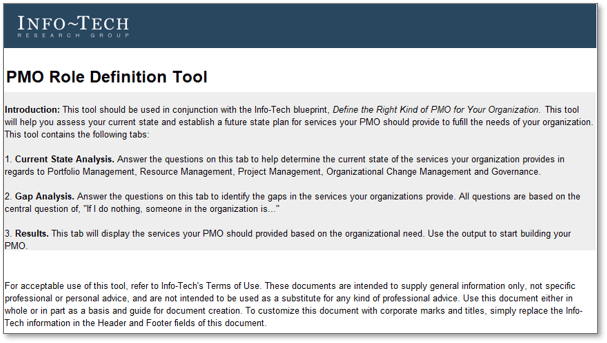
Download the PMO Role Definition Tool
Hey, you don’t to have to spend anything on portfolio, project, and organizational change management! Assuming of course…
|
|
|
Use the tool on the next slide to see where you may need to spend.
1.2.1 Assess the current state of your project environment
20-30 minutes
Input: Understanding of current project portfolio environment
Output: Completed current state survey
Materials: Tab 1 of Info-Tech’s PMO Role Definition Tool
Participants: PMO director and/or portfolio manager, PMO staff/stakeholders, Project managers
Screenshot from tab 1 of Info-Tech’s PMO Role Definition Tool.
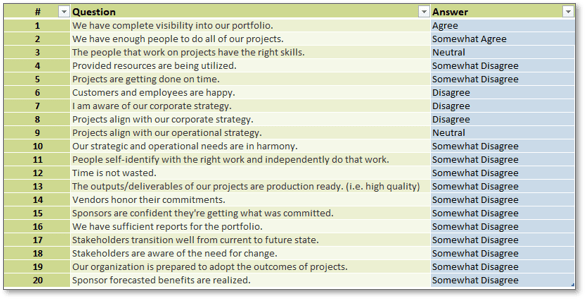
There are 20 current-state questions in column C. Together, the questions address the five capabilities in Info-Tech’s PMO function matrix (slide 28).
Use the drop-down menu in column D to answer Agree, Somewhat Agree, Neutral, Somewhat Disagree, or Disagree to each question in column C.
The questions are broad by design. Answer them honestly and select “neutral” if anything is not applicable.
1.2.2 Set your target state needs to identify gaps
15-30 minutes
Input: Reflection on the question, “If I/We do nothing, someone in the organization is…”
Output: Completed target state survey
Materials: Tab 2 of Info-Tech’s PMO Role Definition Tool
Participants: PMO director and/or portfolio manager, PMO staff/stakeholders, Project managers
Screenshot from tab 2 of Info-Tech’s PMO Role Definition Tool.
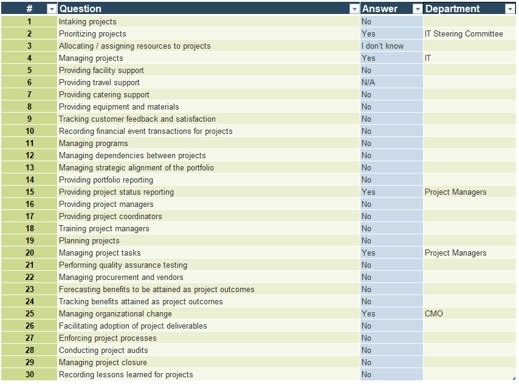
Each question in column C of tab 2 should be answered in the context of, “If I do nothing, someone in the organization is…”
Answer each question by using the drop-down menu in column D to select “Yes,” “No,” “I don’t know,” or “N/A.”
If “Yes” include the department or area that is responsible.
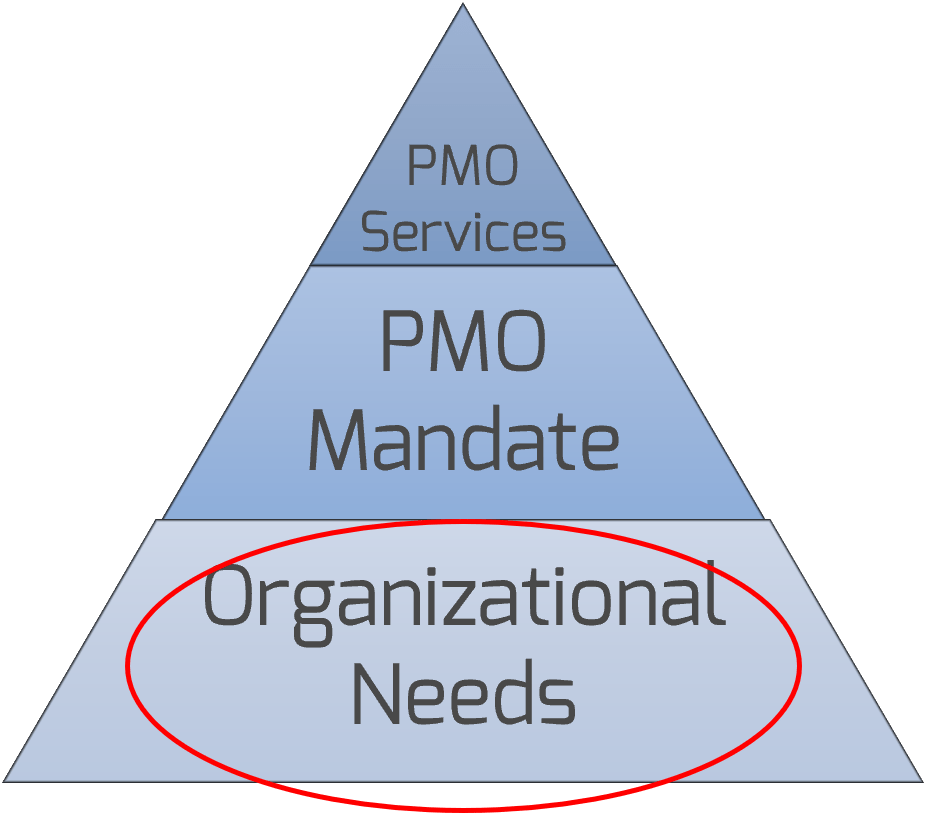
Review the preliminary list of your potential PMO functions
Tab 3 of the PMO Role Definition Tool contains a customized version of Info-Tech’s PMO definition matrix, based upon your inputs in the previous two tabs.
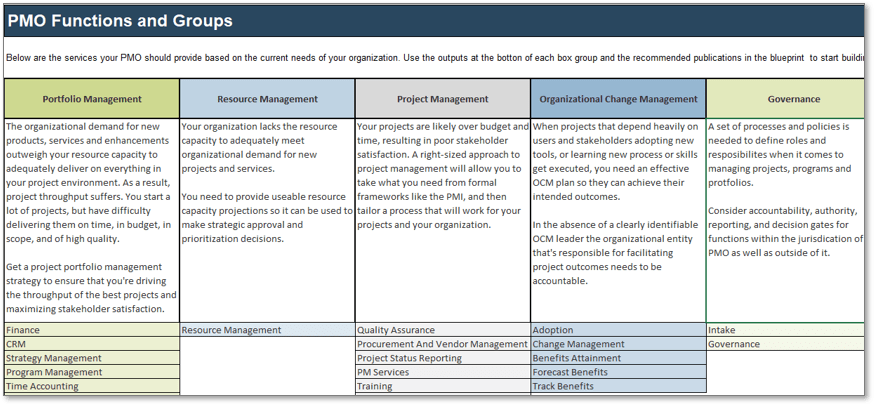
The name of the box is the group the function belongs to.
These outputs are based on the answers to the questions on the previous 2 tabs.
In each group’s box are high-level recommendations.
Consider your stakeholders
Who benefits from the new or updated PMO structure?
In a matrix environment, understanding the challenges other teams are facing is a core requirement of an effective PMO. The best way to understand this is through direct engagement like conducting interviews and taking surveys with management and members of other teams.
Ask yourself these questions about your PMO:
- Are we doing the right things?
- Do we know the current status of projects?
- Are we managing, escalating, and resolving project issues?
- Do PMs have the right training?
- What is our overall utilization?
A PMO should be structured to provide service to the organization. View it as a business, serving the stakeholders.
1.2.3 Complete this vision exercise to produce an initial mandate for a new/improved PMO
45-60 minutes
Input: Outputs from SWOT analysis
Output: An initial PMO mandate
Materials: Whiteboard/flip charts, Sticky notes
Participants: PMO director and/or portfolio manager, PMO staff/stakeholders, Project managers
Now that you have an idea of the services your organization needs from steps 1.1 and 1.2 of this blueprint, you can discuss the target state of your PMO.
Follow these steps to complete the SWOT analysis:
- Each person writes one aspect of a future state that would solve the issues described in the SWOT analysis (activity 1.1.1). Use sticky notes and post them on the whiteboard.
- As a group, identify which of these aspects would be good candidates for embodying the “core element” of your PMO’s new mandate.
- From the aspects gathered, have everyone individually come up with a statement of one to two sentences they think captures the overall theme and vision of this PMO.
- Collectively choose the best statement to use as the working mandate for your new project management office. This mandate can be modified as needed in the time leading up the creation and launch of your PMO.
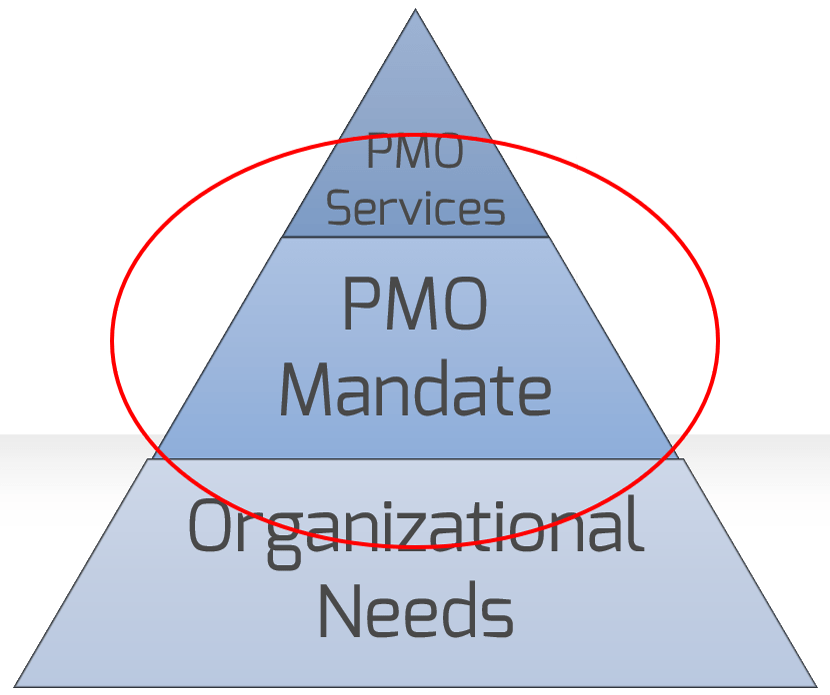
1.2.4 Use Info-Tech’s PMO Project Charter template to help capture your mandate and obtain approval
3-4 hours
Input: Activity 1.2.3, Logical considerations for PMO deployment (see bulleted list on this slide)
Output: An assessment of current strengths, opportunities, threats, and weaknesses of capabilities in previous slide
Materials: Whiteboard/flip charts, Sticky notes
Participants: PMO director and/or portfolio manager, PMO staff/stakeholders, Project managers
A successful PMO will offer a range of services which business units can rely on. The aim of the PMO charter is to outline what is in scope for the PMO and what services it will initially offer.
A project charter serves several important functions. It organizes the project so you can make efficient and effective resource allocation decisions. It also communicates important details about the project purpose, scope definition, and project parameters.
To use this template, simply modify or delete all information in grey text and convert the remaining text to black before printing or sending. Sections within the Template include:
- PMO Mandate
- Goals & Benefits
- Scope Definition
- Key PMO Stakeholders
- Projected Timeline for Implementation
- Project Roles and Responsibilities
- High-Level Budget
- High-Level Risk Assessment
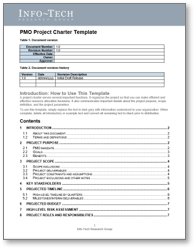
Download the PMO Project Charter Template
Engage leadership to refine target-state expectations

|
?
Will project managers be included in the PMO? Which projects and programs will be in the PMO’s mandate? |
?
Will the PMO have decision-making authority? If so, how much and on what issues? |
?
Where in the organizational structure will the PMO report? |
“Changing the perception of project management from ‘busy work’ to ‘valued efforts’ is easier when the PMO is properly aligned.” (Project Management Institute, October 2009)
Don’t assume your PMO is merely tactical
It can help drive strategy instead of just being a technical arm.
Strategic |

|
Tactical |
| Strategic Alignment
Leadership assumes that your presence will optimize the alignment of projects to corporate strategy. |
Process Adherence
Leadership assumes you’re all about process. |
|
| Portfolio Thinking
Leadership assumes that you’re thinking about the overall throughput of projects through the portfolio. |
Project Thinking
Leadership assumes you’re not thinking beyond the boundaries of a single project at any given time. |
|
| Outcomes Focused
Leadership assumes that you’re focused on the outcomes forecast by sponsors. |
Timeline Focused
Leadership assumes you’re focused on delivering projects on time. |
Info-Tech Insight
A key success factor for a PMO is to take part of strategic conversations; when they are left out, it creates a barrier. The PMO is the connective tissue between strategy and tactics. Don’t risk your benefits by not having the PMO Director at the table before you make decisions.
Avoid the disconnect
Create a strategic plan with project professionals at the table.
- Strategic plans should guide organizations to future states, yet many don’t ever get used. This is because there is a disconnect between the people creating the strategic plan and the people being asked to implement it. Strategic planners don’t often develop their plans with the help of project managers who can ensure the plan is transferred into a working operational plan.
- Strategic planners are broad thinkers with high-level plans whereas project professionals often work in the trenches. The disconnect between the two can often result in cost overruns, delays in implementation, low worker morale, and an overall chaotic work environment.
- By putting strategic planners and project managers together to work on the strategic planning process, they can see what the other sees and plan accordingly.
- Twenty-seven percent more projects are executed successfully when a company’s structure and resources align with their strategy (KPMG, 2017).
“The failure to build a bridge between the strategic planning process and project management’s planning process is a major reason strategic plans don’t work.” (Bruce McGraw, Project/Programme Manager)
1.2.5 Strategic planning
1 hourTo create a strategic plan that provides value, recognize that the strategic plan for the PMO is not the PMO charter.
- The PMO charter is the organizational mandate for the PMO. It defines the role, purpose and functions of the PMO. It articulates who the PMO's sponsors and customers are, the services that it offers, and the staffing and support structures required to deliver those services. And, it assumes that a decision to have a PMO has already been made.
- A strategic plan enables the PMO to play an essential role in achieving a company’s business goals, setting out clear objectives and then providing a roadmap on how to achieve them. A strategic plan maps the tools and resources necessary to achieve successful project outcomes.
To create a results-driven strategic plan for your PMO, it is helpful to follow a top-down format:
- Start by going through the list on the right and update the strategic plan.
- What are the top project-related issues and opportunities you want your PMO to address and what’s the value to the business of trusting them?
Vision: this needs to be a vivid and common image
Mission: this is the special assignment that is given to a group
Goals: these are broad statements of future conditions
Objectives: these are operational statements that indicate how much and by when (e.g. deliverables or intangible objectives like productivity)
Strategies: these are the set of actions that need to take place
Needs: these are the things required to carry out the strategy
Critical Success Factors: these are the key areas of activity in which favorable results are necessary to reach the goal
Download the PMO Strategic Plan
Prepare an Actionable Roadmap for Your PMO
Phase 2
Staff Your PMO for Resilience
Phase 1
| Phase 2
| Phase 3
|
Info-Tech’s approach
Follow our two-step approach to successfully staff your PMO.
- Determine your PMO staffing needs.
Our approach to building a PMO starts by analyzing the staffing requirements of your PMO mandate. - Create purpose-built role descriptions.
Once you have an understanding of the staff and skills you’ll need to succeed, we have job description aids you’ll need to fill the roles.
The Info-Tech difference:
- Save time developing a purpose-built approach. There is no one-size-fits-all approach to PMO staffing. The advice and tools in this research will help you quickly determine your unique staffing needs and guide your next steps to get the staffing you need.
- Leverage insider research. We’ve worked with thousands of PMOs and have seen the good, the bad, and the ugly of PMO staffing. The approach in this research is informed by client successes and will help you avoid the common mistakes that drive PMO failure.
IT staff allocation for project work
Projects and Project Portfolio Management
58.3% — 58% of respondents feel they have the appropriate staffing level to execute project management effectively. (Source: Info-Tech IT Staffing Benchmark Report)
59.8% — 59% feel they have the appropriate staffing level to execute requirements gathering effectively. (Source: Info-Tech IT Staffing Benchmark Report)
The GDP contributions from project-oriented industries are forecasted to reach $20.2 trillion over the next 20 years. (Source: “Project Management: Job Growth and Talent Gap” Project Management Institute, 2017)
Info-Tech Insight
Project work is only going to increase, and in general, people are dissatisfied with their current staffing levels.
Step 2.1
Identify Organizational Design
Activities
- 2.1.1 Right, Wrong, Missing, Confusing
- 2.1.2 Map Your Current Structure
- 2.1.3 Inventory Assessment
- 2.1.4 Job Description Survey
This step will walk you through the following activities:
- Complete a Right, Wrong, Missing, Confusing analysis
- Determine your current organizational/PMO structure
- Assess your current inventory
- Complete the job description survey
This step involves the following participants:
- PMO director and/or portfolio manager
- PMO staff/stakeholders
- Project managers
Outcomes of this step
- Current-state analysis
- Job description survey results
Staff Your PMO for Resilience
| Step 2.1 | Step 2.2 |
2.1.1 Right, wrong, missing, confusing
30-45 minutes
Input: Current PMO process, Current PMO org. chart
Output: An assessment of current things that are being done right and wrong and what is currently missing and confusing
Materials: Whiteboard/flip charts, Sticky notes
Participants: PMO director and/or portfolio manager, PMO staff, Project managers
Perform a right, wrong, missing, confusing analysis to assess the current state of your PMO and its staff.
The purpose of this exercise is to begin to define the goals of this implementation by assessing your staffing capabilities and cultivating alignment around the most critical opportunities and challenges.
Follow these steps to complete the analysis:
- Have participants discuss what is wrong, right, missing, and confusing.
- Spend roughly 45 minutes on this. Use a whiteboard, flip chart, or PowerPoint slide to document results of the discussion as points are made.
- Make sure results are recorded and saved by taking a picture of the whiteboard or flip chart.
Organizational types
- Functional
Functional organizations are structured around the functions the organization needs to be performed. - Projectized
Projectized organizations are organized around projects for maximal project management effectiveness. - Matrix
Matrix organizations have structures that blend the characteristics of functional and projectized organizations.
Functional organization
The traditional hierarchical organizational structure.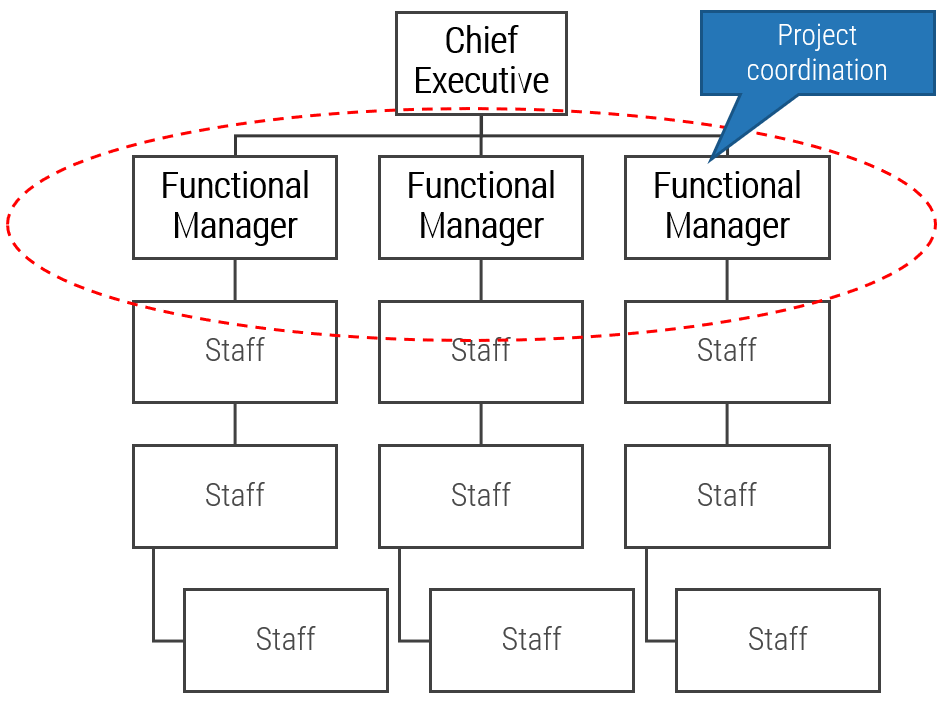
Adapted from ProjectEngineer, 2019 |
|
Projectized organization
The majority of project resources are involved in project work.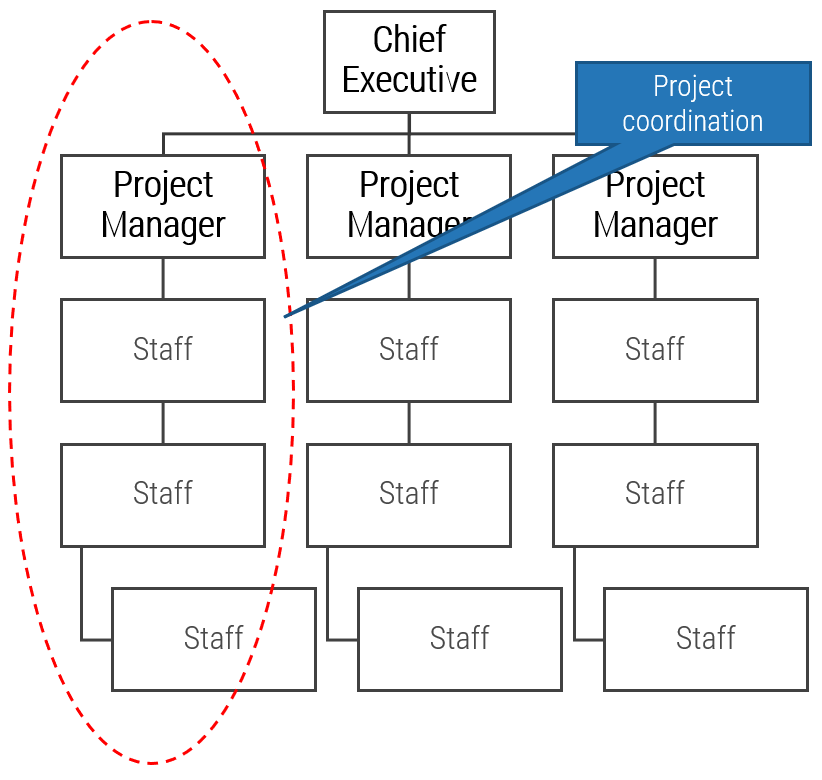
Adapted from ProjectEngineer, 2019 |
|
Matrix organization
A combination of functional and projectized.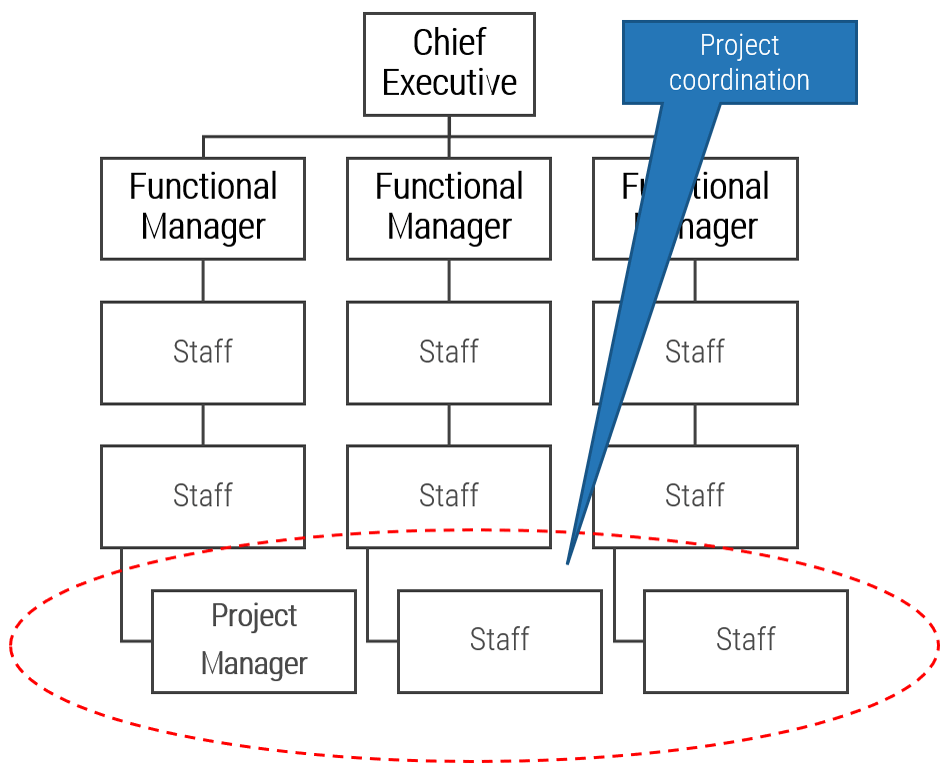
Adapted from ProjectEngineer, 2019 |
|
The project management office
The vast majority of PMOs are understaffed and underequipped.
- They are often born out of necessity or desperation.
- They have no long-terms goals; they tend to go from year to year trying to meet the organization’s needs.
- They don’t have clear mandates, so it is difficult to determine how they are providing value.
- Over time (and sometimes even from day one), project management offices find that other tasks fall into their area of responsibility. This often happens when the work has nowhere else to go.
- Resource management is the challenge, both in terms of being able to allocate skilled resources to projects and within the PMO itself. Staffing gaps within the PMO are often met by individuals wearing more than one hat.

2.1.2 Map your current structure
30 minutes to 1 hourInput: Current org. charts and PMO structures, Info-Tech’s PMO Function Matrix
Output: Structure chart
Materials: Whiteboard/flip charts
Participants: PMO director and/or portfolio manager, PMO staff, Project managers
- As a group, review your current organizational and PMO structure.
- Map out both, or if your PMO is small, map out how it fits into the overall structure.
- Make sure to think about your process, reporting structures, and escalation hierarchies.
- Consider the capabilities on slide 59 as you work.
- Use the sample structure on the next page as a guide.

Sample PMO structure
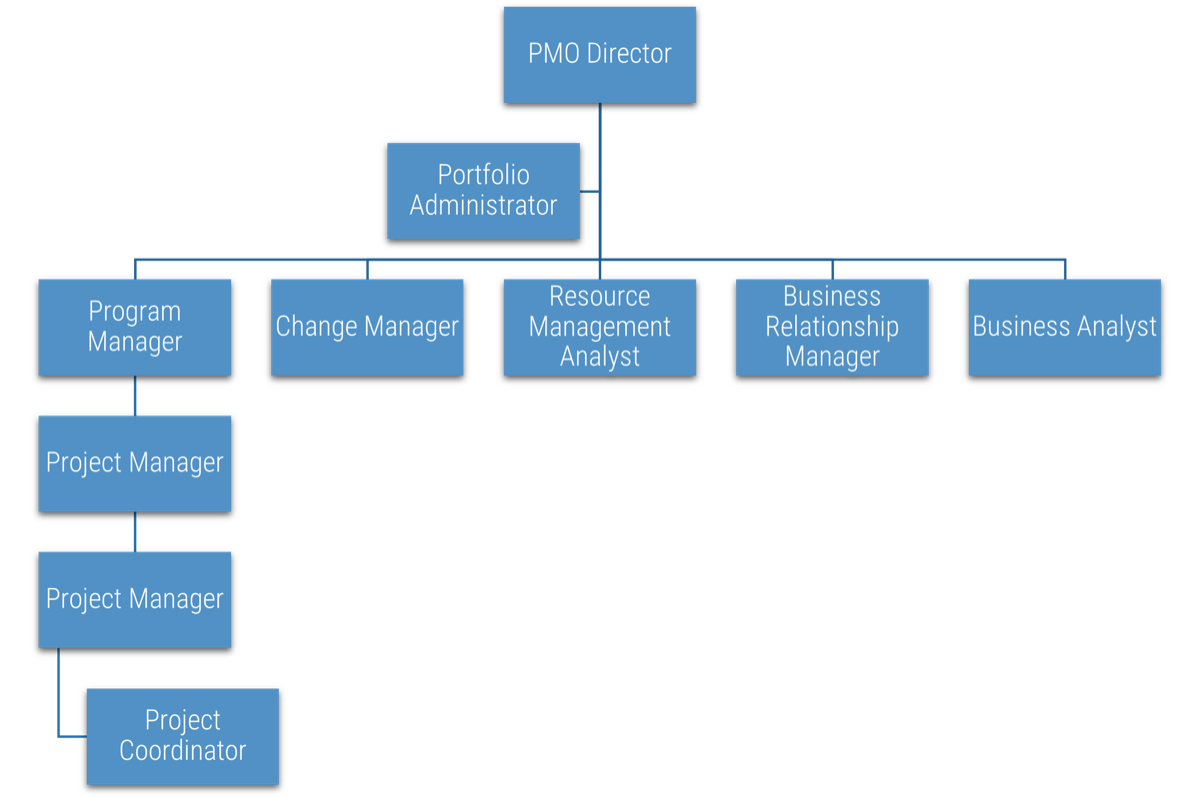
|

|
Info-Tech’s PMO Function Matrix
Info-Tech’s potential PMO capabilities are in the header of the table below.
| Portfolio Management | Resource Management | Project Management | Organizational Change Management | PMO Governance | |||
| Recordkeeping and bookkeeping | Strategy management | Assessment of available supply of people and their time | Project status reporting | PM SOP (e.g. feed the portfolio, project planning, task managing) |
Benefits management | Technology and infrastructure | |
| Reporting | Financial management | HR | Security | ||||
| PMIS | Intake | Matching supply to demand based on time, cost, scope, and skill set requirements | Procurement and vendor management | Legal | Financial | ||
| CRM/RM/BRM | Program management | ||||||
| Tracking of utilization based on the allocations | Quality | Intake | |||||
| Time Accounting | PM services (e.g. staffing project managers or coordinators) |
Quality assurance | Organizational change management | Project progress, visibility, and process | |||
| Forecasting of utilization via supply-demand reconciliation | Closure and lessons learned | ||||||
| Administrative support | PM Training | ||||||
2.1.3 Inventory assessment
30-45 minutes
Input: Understanding of your current situation regarding project intake and process
Output: Survey results
Materials: Whiteboard/flip charts
Participants: PMO director and/or portfolio manager, PMO staff, Project managers
When staffing your PMO, it is important to understand your current situation regarding project intake and process.
Answer the following questions, and be as detailed as possible:
- What is your project intake process?
- How many projects do you currently have?
- How many people lead projects?
- Are those who lead projects distributed (federated) or centralized?
- What tools do you use to manage your portfolio, projects, and resources?

2.1.4 Job description survey
45 minutes to 1 hour
Input: Tab 1 of the PMO Job Description Builder Workbook
Output: List of current projects, processes, and tools
Materials: PMO Job Description Builder Workbook
Participants: PMO director and/or portfolio manager, PMO staff, Project managers
On tab 1 of the PMO Job Description Builder Workbook, use the survey to help determine potential role requirements across various project portfolio management, project management, business analysis, and organizational change management activities.
Follow these steps to complete the survey:
- Consider the role that you are trying to fill.
- Read each question carefully and use the drop-down menu to answer whether the activity in column C is a core, ancillary, or out-of-scope job duty.
Download the PMO Job Description Builder Workbook
2.1.4 Job description survey continued
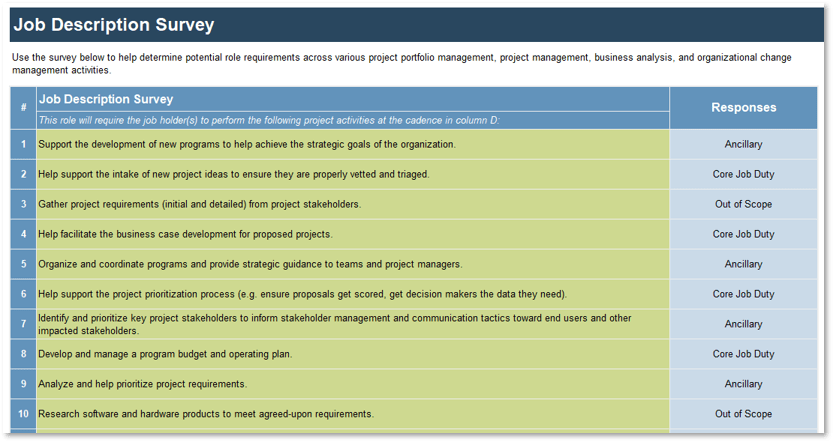
Step 2.2
Build Job Descriptions
Activities
- 2.2.1 Analyze Survey Results
- 2.2.2 FTE Analysis
- 2.2.3 Create Your Job Descriptions
This step will walk you through the following activities:
- Complete the PMO Job Description Builder Workbook
- Create job descriptions
This step involves the following participants:
- PMO director and/or portfolio manager
- PMO staff/stakeholders
- Project managers
Outcomes of this step
- PMO org. chart
- Completed job descriptions
Staff Your PMO for Resilience
| Step 2.1 | Step 2.2 |
2.2.1 Analyze survey results
30 minutesTab 2 of the PMO Job Description Builder Workbook shows the survey results from tab 1.
The job activities are ranked in a prioritized list. The analysis will help you determine if you require a portfolio manager, program manager, project manager, business analyst, organizational change manager, or a combination.
Follow these steps to analyze your results:
- Digest the prioritized ranking. The job activities are ranked in a prioritized list (from most essential to the role to least essential) in column D. The core process or capability that corresponds to each activity is listed in column C.
- Use the drop-down menu in column F to decide if the core job duties and ancillary job duties will or will not be included in the role description. Out-of-scope activities will automatically be removed.
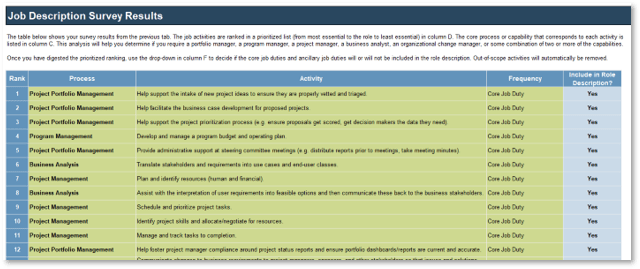
Download the PMO Job Description Builder Workbook
2.2.2 FTE analysis
30 minutes
Input: Tab 3 of the PMO Job Description Builder Workbook
Output: Total estimated monthly time commitments, Preliminary FTE analysis
Materials: PMO Job Description Builder Workbook
Participants: PMO director and/or portfolio manager, PMO staff, Project managers
Tab 3 of the PMO Job Description Builder Workbook is used to complete the FTE analysis.
Download the PMO Job Description Builder Workbook
2.2.2 FTE analysis continued
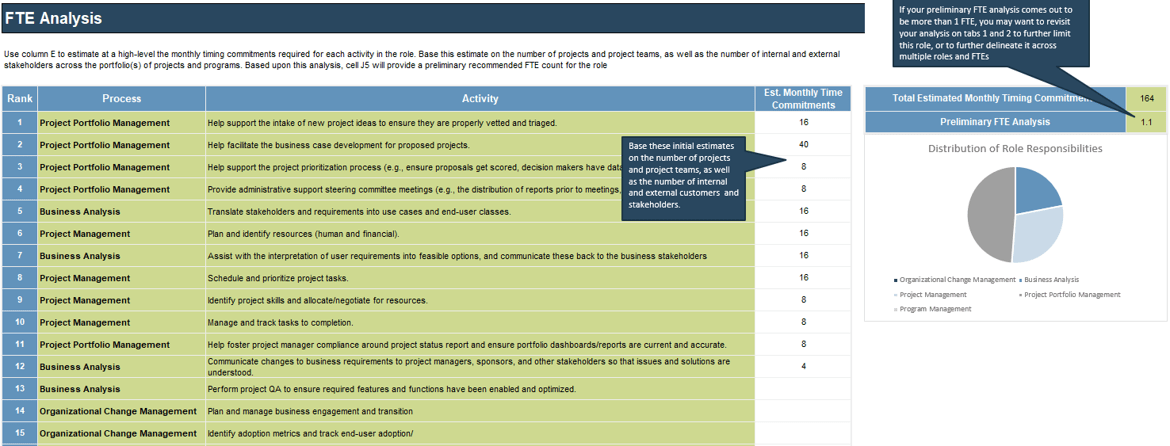
On tab 3, use column E to estimate the monthly time commitments required for each activity in the role.
Tip: Base estimates on the number of projects and project teams as well as the number of internal and external stakeholders across the portfolio(s) of projects and programs.
Cell J5 will provide a preliminary recommended FTE count for the role.
Job description content
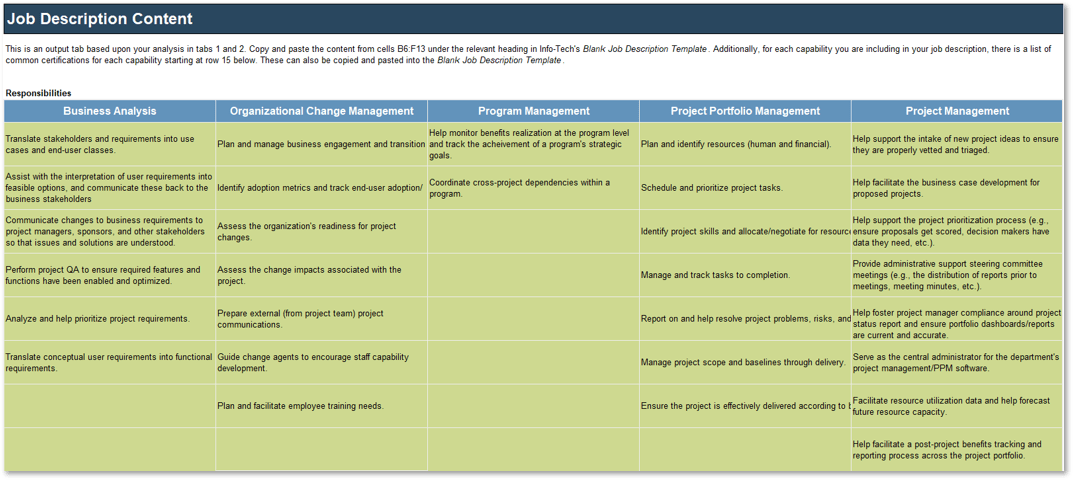
This is an output tab based on your analysis in tabs 1 and 2. Copy and paste the content and add it under the relevant heading in Info-Tech's Blank Job Description Template later in this blueprint.

For each capability you are including in your job description, there is a list of common certifications. These can also be copied and pasted into the Blank Job Description Template.
Download the PMO Job Description Builder Workbook
How to determine the roles in your PMO
It’s not black and white.
While your PMO should have someone to lead the team, aside from that it’s hard to be specific about the exact roles your PMO needs without understanding the needs of your organization.
This is why it’s important to define your PMO first. Your team members should best support the function and capabilities of your PMO.
For example:
- If you want to provide a training program to project managers, you’ll need your PMO to have people with experience delivering training and with experience having done the job before.
- If your PMO provides management information and deep portfolio analysis, you’ll need someone on the team who knows their way around data analysis tools.
You should have a mix of skills in the PMO team, each complementing the others. You may have administrators and coordinators, data analysts and software experts, trainers, coaches, and senior managers.
“If you want to go fast, go alone. If you want to go far, go together.” (African proverb)
Managing projects and building PMOs are not the same thing
Your best project manager should be running projects, and, no, they can’t do both.
- Your new PMO needs a leader to get it off the ground, but don’t assume that the best project manager is best suited to build the PMO. The goal-oriented passion of a successful project manager may prove to be antithetical to the forward-looking finesse and political acumen needed to develop and staff the PMO as an organizational unit. Avoid the common mistake of promoting effective people into positions where they become ineffective, a concept often referred to as “The Peter Principle.”
- You can’t determine if your best project manager fits the PMO leadership role if the PMO’s role isn’t clearly defined. Carefully define and clearly articulate the PMO’s role to understand the skill set needed to develop and lead your PMO.
- Project managers often propose to create a PMO without considering the fit with project portfolio management and organizational change management. If the leadership doesn’t understand the magnitude of what is being requested, they may well think a project manager is best suited to run the PMO. The prestige and/or compensation is attractive, but project managers will often spin their wheels and naturally focus on what they know how to do: manage projects. Start with a PMO design to align with business expectations.
The Peter Principle
The Peter Principle was first introduced by Canadian sociologist Laurence Johnston Peter describing the pitfalls of bureaucratic organizations. The original principle states that "in a hierarchically structured administration, people tend to be promoted up to their level of incompetence.” The principle is based on the observation that whenever someone succeeds at their job, the organizational response is to promote them, thus people will continue to be promoted until they reach a point where they’re no longer excelling at their job. At that point, they would no longer be promoted. Followed to its logical conclusion, organizations will continue to take successful people and rotate them to new positions until they are no longer effective.
PMO Director/Lead
Job overviews for different kinds of PMO directors.
The job descriptions on the next few pages are associated with the descriptive headings, but it is important to recognize that these diverse roles can all fall under the job title of PMO director.
Portfolio Management
As PMO director, you will oversee the throughput of IT projects using portfolio management, project management, and organizational change management disciplines.
You and your team will directly manage the intake of new project requests, the preparation of evaluation-ready project proposals, and the handoff of approved project initiation documents to project managers in other departments. You will forecast and track the availability of people to do the project work throughout the project life cycle. You will publish monthly and annual portfolio reporting based on information collected from the project teams, and you will oversee the closure of projects with follow-up reporting to those who approved them.
From time to time, the PMO may be required to identify projects that should be frozen or canceled based on criteria set forth by the leadership and/or industry best practices.
While currently out of scope, successful candidates should be comfortable with the possibility that the PMO may required to develop full life cycle organizational change management in the future. As well, experienced project managers in the PMO may be required to manage high-risk, high-visibility projects from time to time.
PMO Director/Lead
Job overviews for different kinds of PMO directors.
Project Management
As PMO director, you will oversee a team of professional project managers who are responsible for the company’s high-risk, high-visibility, and strategic projects.
You and your team will receive initiation documents and assigned resourcing for approved projects from the company’s authorized decision makers. You will manage the fulfillment of the project requirements, providing regular status updates to project and portfolio stakeholders and escalating concerns when projects are struggling to meet their commitments for scope, cost, and timelines.
Over time, the PMO will take on an increasing role in organizational change management. The PMO will transition its focus from project delivery to business outcomes. Over time, the PMO will transition project sponsors from articulating requirements to delivering results.
Project Policy
As PMO director, you will oversee the establishment, support, and promotion of company-wide standards for project management.
You and your team will modernize and maintain the company policy manuals and processes for everything related to project management. You will adapt our legacy PMBOK-based standards to cover iterative project management approaches as well as the more formal approaches required for construction projects, outsourced projects, and a wide variety of non-IT projects.
PMO Director/Lead
Job overviews for different kinds of PMO directors.
Project Governance
As PMO director, you will oversee the governance of project spending, delivery, and impact.
You and your team will ensure that project proposals address the broad needs of the organization via strategic alignment, operational alignment, appropriateness of timing, identification and management of risk, and ability to execute. You will represent the needs and interests of the shareholder, ratepayer, or constituent by validating adherence to the organization’s published policies for project, portfolio, and organizational change management.
The PMO is independent from the broader information technology division and will retain a mandate to ensure transparency and disclosure relative to the consumption of the organization’s scarce resources in the pursuit of high-risk IT projects.

Info-Tech sample job descriptions
Use the sample job descriptions available with this blueprint as a guide when creating your descriptions.

2.2.3 Create your job descriptions
30 minutes
Input: PMO Job Description Builder Workbook
Output: Job descriptions
Materials: Blank Job Description Template
Participants: PMO director and/or portfolio manager, PMO staff, Project managers
When you’ve determined the roles you need, you can start creating your job descriptions. If none of our out-of-the-box, pre-populated job description templates suit your needs, use the results of Info-Tech’s PMO Job Description Builder Workbook and the Blank Job Description Template to create your purpose-built job description.
Follow these steps to create your job description:
- Copy the content from tab 4 of the PMO Job Description Builder Workbook and paste it under the relevant headings in the “Responsibilities” section of the Blank Job Description Template. Delete any unused headings if they are not relevant to your role. Additionally, use the list of common certifications on tab 4 of the Workbook to inform that section of the Blank Job Description Template.
- Use the sample job descriptions on the blueprint landing page as a guide for filling out the remaining sections of the document.
Download the Blank Job Description Template
2.2.3 Create your job descriptions continued
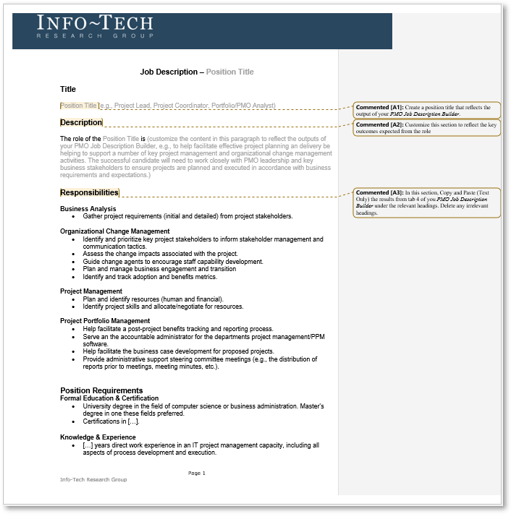
Prepare an Actionable Roadmap for Your PMO
Phase 3
Prepare an Actionable Roadmap for Your PMO
Phase 1
| Phase 2
| Phase 3
|
Having a strategy is essential but real value and benefits are delivered through projects
9.9% of every dollar is wasted due to poor project performance
52% of projects are delivered to stakeholder satisfaction
51% of projects are likely to meet original the goal and business intent
(Source: Project Management Institute, 2018)
You’re always going to have troubled projects
Have the organizational discipline to step away from the mess and develop a plan.
- The world of modern project management has been in place for over 50 years and yet business leaders still seem to put the pressure on troubled projects instead of broken processes.
- With higher portfolio maturity comes higher performance, warranting investment in the PMO.
- Instead of alternative cost-reduction measures, such as stopping an individual project, we find that PMO resources (or the entire PMO) are being cut. In most cases, this demonstrates a lack of understanding of the value of portfolio management processes and related impacts.
- Plan for a series of improvements over time so you’re not continually using your PMO resources on troubled projects. Instead, maintain an ongoing focus on improvement.

“If I had six hours to chop down a tree, I’d spend the first four hours sharpening the axe.” (Anonymous woodsman)
All improvements cannot be done at once
|

|
A PMO can benefit your business and organization as a whole
Your PMO can:
- Help to align the project or portfolio with a focus on the future strategy of the organization.
- Be a mechanism to deliver projects successfully, keep them on track, and report when scheduling, budget, and other scope issues could derail the project.
- Create a portfolio of projects and understand the links and dependencies between the projects. This provides you with a bird's-eye view to make better decisions based on changes as they arise.
- Facilitate better communications with customers and stakeholders.
- Enforce project management governance and ensure consistent standards throughout the organization.
- Strategize on how to best use shared resources and best use them productively.
“If you run projects and the projects have a significant level of cost or have significant level of impact, then you can really benefit from a PMO. Certainly, the larger the projects, the bigger the budget, the more there are projects, then the more you can benefit from a PMO.” (Michael Fritsch, Vice President PMO, Confoe)
“PMOs are there to ensure project and program success and that’s critical because organizations deliver value through projects and programs.” (Brian Weiss, Vice President, Practitioner Career Development, Project Management Institute)
Step 3.1
Create Roadmap
Activities
- 3.1.1 Business Goals
- 3.1.2 Roadmap
- 3.1.3 Resources
This step will walk you through the following activities:
- Determine business goals
- Create roadmap
- Establish resources
This step involves the following participants:
- PMO director and/or portfolio manager
- PMO staff/stakeholders
- Project managers
Outcomes of this step
- PMO roadmap aligned to business goals
Prepare an Actionable Roadmap for Your PMO
| Step 3.1 | Step 3.2 |
3.1.1 Business goals and priorities
30 minutes
Input: Business strategies and goals, Current PMO org. chart
Output: An initial short, medium, long-term roadmap of initiatives
Materials: Whiteboard/flip charts, Sticky notes, Slide 83
Participants: IT leaders/CIO, PMO director and/or portfolio manager, PMO staff, Project managers
When you are determining what your PMO will provide in the future, it is important to align the ambition of the PMO with the maturity of the business. Too often, a lot of effort is spent trying to convince businesses of the value of a PMO.
Before you develop your roadmap, try to seek out the key strategies that the business is currently driving to get the proper ownership for the proposed initiatives.
- What does leadership want to accomplish?
- What are the key strategies the business is currently driving?
- What are the current pain points?
Once you’ve established the business strategies, start mapping out your initiatives:
- For each initiative, consider the activities you think will work best to take you from your current to future state. It’s okay to keep this high level, we will break them down later in the blueprint.
- Don’t place activities on a roadmap with dates yet. Use the table on the next slide to record the activities against each initiative at a high level.
| Current State Business Strategies | PMO Initiatives | Future State Business Strategies | |||
| Short Term | Medium Term | Long Term | |||
| Portfolio Management | Project Intake Process
Triage Process Project Levelling Book of Record |
Approval
Prioritization Reporting |
Resource Allocation | ||
| Resource Management | |||||
| Project Management | Standardize Project Management
Methodologies |
PM Training | |||
| Organizational Change Management | Benefits | ||||
| Governance | Project progress, visibility, and process
Documentation |
||||
3.1.2 Create your roadmap
1-2 hoursServices should be introduced gradually and your PMO roadmap should clearly highlight this and explain when key deliverables will be achieved.
Consider the below top-level tasks and add any others that pertain to your organization:
- Enable Transition
- Establish Governance
- Organizational Chart
- Technology and Infrastructure
- Develop Portfolio Management Capabilities and Guidelines
- Standardize Project Management Methodology
- Organizational Change Management
- Strategy Management
Download Info-Tech’s PMO MS Project Plan Sample to see a full list of top-level tasks and second-level tasks. Once done, you can visually plot the tasks on a roadmap. See the next few slides for roadmap visuals.

Download the PMO MS Project Plan Sample
Screenshot of PMO MS Project Plan Sample
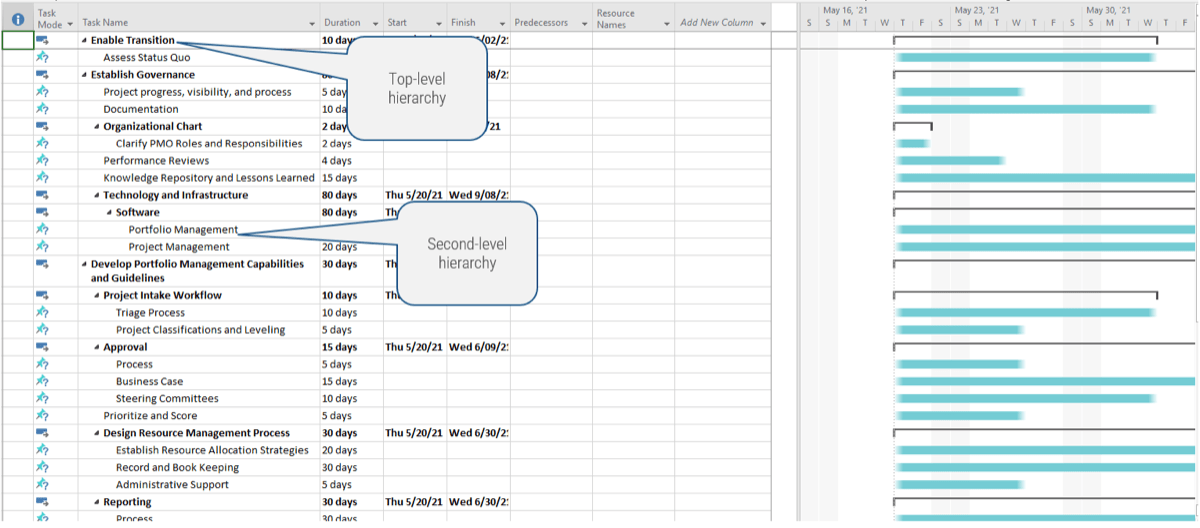
Sample roadmap
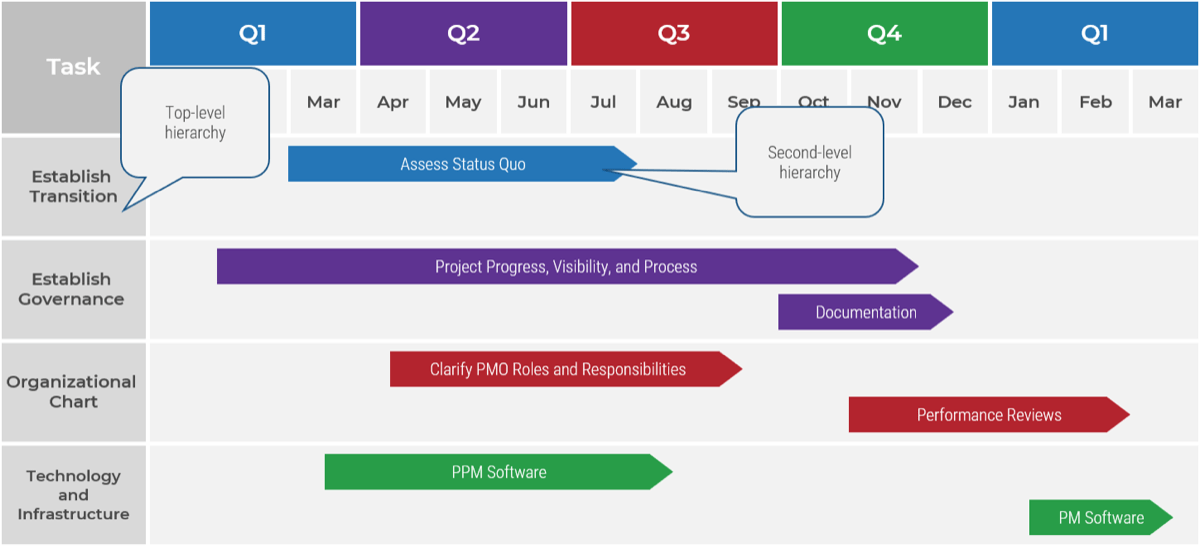
Sample roadmap
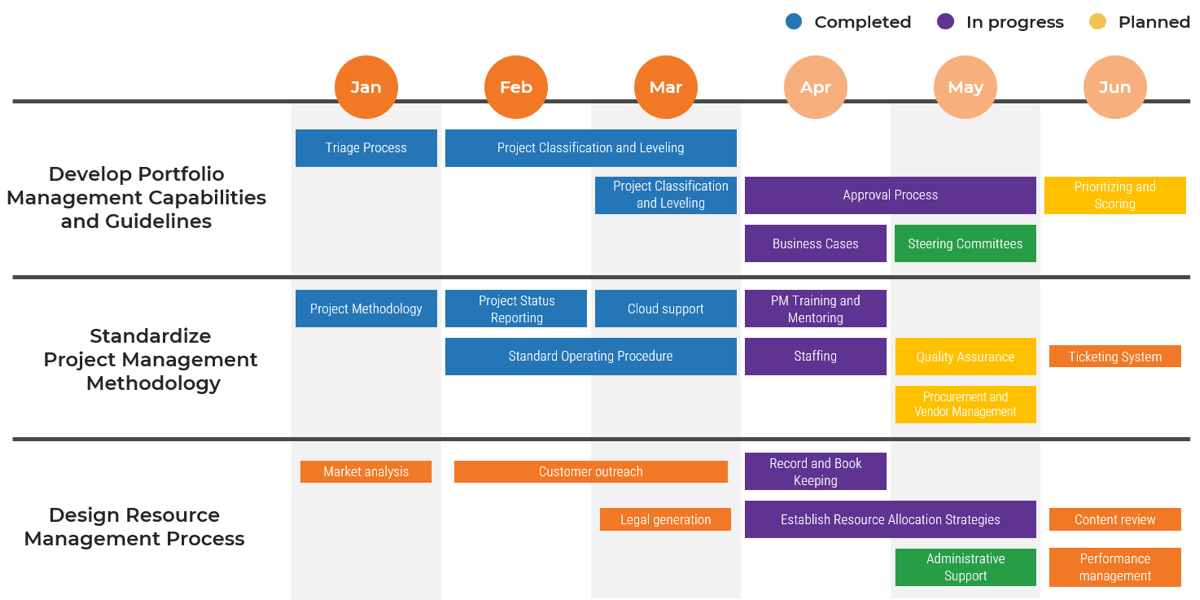
Consider the resources you will need
Use these Info-Tech resources to make sure your roadmap will be successful.
Finances – Understand and be transparent about the real costs of your project.
People – Strategize according to skill sets and availability. Use the org. chart in phase 2 of this blueprint as a starting place (slide 58).
Assets – Determine the tangible resources you may buy like software and licenses.

3.1.3 Define resources
30 minutes
Input: Project documentation, Current resources
Output: List of resources for your PMO
Materials: Whiteboard/flip charts
Participants: IT leaders/CIO, PMO director and/or portfolio manager, PMO staff, Project managers
Resources for your projects include staff, equipment, and materials. Resource management at the PMO level will help you manage those resources, get visibility into projects, and keep them moving forward. Be sure to consider the resources that will get your PMO off the ground.
Determine the resources you currently have and the resources your PMO will need and add them to your strategic plan:
- Finances — It’s essential that you know, and are transparent about, the real cost of creating your PMO and new process. Don’t forget to consider post deployment costs as well.
- People — Every project depends on the skill sets that individual team members bring to the table. Strategize according to these skill sets and their availability for the duration of a project. Some team members may have other work responsibilities and limited time for the project, so you need to accommodate this.
- Assets — These include the tangible resources you may have to buy, lease, or arrange for, such as workspace, software and licenses, computer hardware, testing equipment, and so on.
Step 3.2
Governance and OCM
Activities
- 3.2.1 Governance
- 3.2.2 OCM
- 3.2.3 Perform a Change Impact Analysis
- 3.2.4 Determine Dimensions of Change
- 3.2.5 Determine Depth of Impact
This step will walk you through the following activities:
- Assess/understand governance
- Conduct impact analysis
This step involves the following participants:
- PMO director and/or portfolio manager
- PMO staff/stakeholders
- Project managers
Outcomes of this step
- Governance Structures
- Organizational Change Management Impact Analysis Tool
Prepare an Actionable Roadmap for Your PMO
| Step 3.1 | Step 3.2 |
Clearly define the authority your PMO will have
The following section includes slides from Info-Tech’s Make Governance Adaptable blueprint. Download the blueprint to dive deeper into IT governance.
Governance is an important part of building a strong PMO. A PMO governance framework defines the authority and the support it requires to maximize portfolio and project management capabilities throughout the business. It should sit within your overall governance framework and as the PMO matures, its roles and responsibilities will also change to adapt with business demands and additional capabilities.
Your framework can:
- Specify PMO authority
- Introduce and apply process standards, polices, and directives as it pertains to project and portfolio management
- Facilitate executive and leadership involvement
- Foster a collaborative environment between the PMO and the business
A PMO governance framework enables PMO leaders to establish the common guidelines and manage the distribution of authority given to the PMO.
Visit Make Your IT Governance Adaptable

Common causes of poor governance
Key causes of poor or misaligned governance
|
Five key symptoms of ineffective governance committees
|
IT PMO
Chair:
Updated:
Mandate
Ensure business value is achieved through information and technology (IT) investments by aligning strategic objectives and client needs with IT initiatives and their outcomes.
Committee Goals
- Maximize throughput of the most valuable projects
- Ensure visibility of current and pending projects
- Minimize resource waste and optimize of alignment of skills to assignments
- Clarify accountability for post-project benefits attainment and facilitate the tracking/reporting of those benefits
- Drive approval and prioritization of IT initiatives based on their alignment with business goals and strategy
- Establish a consistent process for handling intake/demand
Committee Metrics
- % of approved IT initiatives that measure benefit achievement upon completion
- % of IT initiatives with direct alignment to organizational strategic direction
- % of initiatives approved by exception
Decisions and responsibilities by purpose
| Responsibilities | ||||
| STRATEGIC ALIGNMENT
Ensure initiatives align with organizational objectives
|
VALUE DELIVERY
|
RISK MANAGEMENT
Assess risk as a factor of prioritizing and approving initiatives |
RESOURCE MANAGEMENT
Decide on the allocation of IT resources |
PERFORMANCE MEASUREMENT
Ensure process is in place to measure and validate performance of IT initiatives |
| Committee Membership | ||||
| Role
CIO, Product Owner, Service Owner, IT VPs, BRM, PMO Director, CISO/CRO |
Individual | |||
IT Steering Committee
Chair:
Updated:
Mandate
Ensure business value is achieved through information and technology (IT) investments by aligning strategic objectives and client needs with IT initiatives and their outcomes.
Committee Goals
- Align IT initiatives with organizational goals
- Evaluate, approve, and prioritize IT initiatives
- Approve IT strategy
- Reinforce (if provided) or establish risk appetite and threshold
- Confirm value achievement of approved initiatives
- Set target investment mix and optimize IT resource utilization
Committee Metrics
- % of approved IT initiatives that meet or exceed value expectation
- % of IT initiatives with direct alignment to organizational strategic direction
- Level of satisfaction with IT decision making
- % of initiatives approved by exception
Committee Overview
| Committee Name | Committee Membership | Mandate |
| Executive Leadership Committee | CEO, CFO, CTO, CDO, CISO/CRO, CIO, Enterprise Architect/Chief Architect, CPO | Provide strategic and operational leadership to the company by establishing goals, developing strategy, and directing/validating strategic execution. |
| Enterprise Risk Committee | CISO/CRO, CPO, Enterprise Risk Manager, BU Leaders, CFO, CTO, CDO | Govern enterprise risks to ensure that risk information is available and integrated to support governance decision making. Ensure the definition of the organizational risk posture and that an enterprise risk approach is in place. |
| IT Steering Committee | CIO, Product Owner, Service Owner, IT VPs, BRM, PMO Director, CISO/CRO | Ensure business value is achieved through information and technology (IT) investments by aligning strategic objectives and client needs with IT initiatives and their outcomes. |
| IT Risk Council | IT Risk Manager, CISO, IT Directors | Govern IT risks within the context of business strategy and objectives to align the decision-making processes towards the achievement of performance goals. It will also ensure that a risk management framework is in place and risk posture (risk appetite/threshold) is defined. |
| PPM | Portfolio Manager, Project Managers, BRMs | Ensure the best alignment of IT initiatives and program activity to meet the goals of the business. |
| Architectural Review Board | Service/Product Owners, Enterprise Architects, Chief Architect, Domain Architects | Ensure enterprise and related architectures are managed and applied enterprise-wise. Ensure the alignment of IT initiatives to business strategy and architecture and compliance to regulatory standards. Establish architectural standards and guidelines. Review and recommend initiatives. |
| Change Advisory Board | Service/Product Owner, Change Manager, IT Directors or Managers | Ensure changes are assessed, prioritized, and approved to support the change management purpose of optimizing the throughput of successful changes with a minimum of disruption to business function. |
Decisions and responsibilities by purpose
| Responsibilities | ||||
STRATEGIC ALIGNMENT
| VALUE DELIVERY
| RISK MANAGEMENT
| RESOURCE MANAGEMENT
| PERFORMANCE MEASUREMENT
|
| Committee Membership | ||||
| Role CIO, Product Owner, Service Owner, IT VPs, BRM, PMO Director, CISO/CRO | Individual | |||
Sample Governance Model
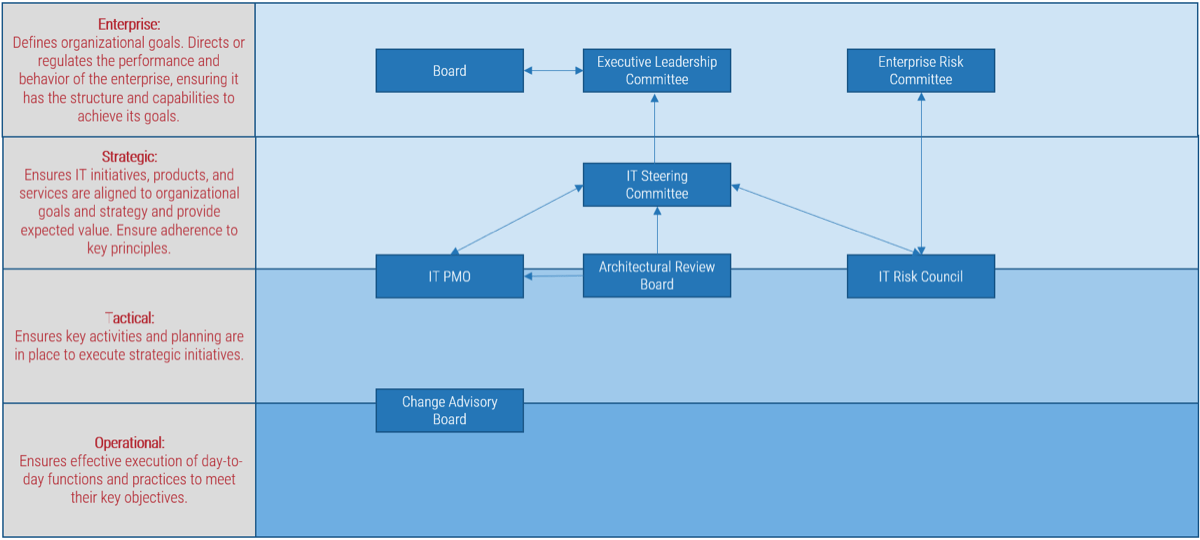
3.2.1 Governance and authority
1-3 hours
Input: List of key tasks
Output: Initial Authority Map
Materials: Whiteboard/flip charts, Sticky notes, Strategic Plan
Participants: IT leadership, Portfolio Manager (PMO Director), PMO Admin Team, Project Managers
Now that you’ve determined the activities on your roadmap, it’s important to determine who is going to be responsible for the following:
- Intake Scoring
- Project Approvals
- Staffing and Resource Management
- Portfolio Reporting
- Communications and Organizational Change Management
- Benefits Attainment
- Formalized Project Closure
- For each task have participants discuss who is ultimately accountable for the decision and who has the ultimate authority to make that decision.
- Place the sticky notes on the swim lanes in the strategic plan to represent the area or person has authority over it.
- Add all initiatives to your PMO governance framework.
Download the PMO Strategic Plan
Governance and Authority
| Committee Name | Committee Membership | |
| Executive Leadership Committee | CEO, CFO, CTO, CDO, CISO/CRO, CIO, Enterprise Architect/Chief Architect, CPO | |
| Enterprise Risk Committee | CISO/CRO, CPO, Enterprise Risk Manager, BU Leaders, CFO, CTO, CDO | |
| IT Steering Committee | CIO, Product Owner, Service Owner, IT VPs, BRM, PMO Director, CISO/CRO | |
| IT Risk Council | IT Risk Manager, CISO, IT Directors, | |
| PPM | Portfolio Manager, Project Managers, BRMs | |
| Architectural Review Board | Service/Product Owners, Enterprise Architects, Chief Architect, Domain Architects | |
| Change Advisory Board | Service/Product Owner, Change Manager, IT Directors or Managers |
PMO Governance Framework
PMO Authority
|
Standards and Policies
|
Guidelines
|
Executive Oversight
|
Customize groupings as appropriate.
Document key achievements governance initiatives.
Completed projects aren’t necessarily successful projects
The constraints that drive project management (time, scope, and budget) are insufficient for driving the overall success of project efforts.
For instance, a project may come in on time, on budget, and in scope, but…
- …if users and stakeholders fail to adopt…
- …and the intended benefits are not achieved...
…then that “successful project” represents a massive waste of the organization’s time and resources.
Organizational change management (OCM) is a supplement to project management that is needed to ensure the intended value is realized. It is the practice through which the PMO or other body can improve user adoption rates and maximize project benefits. Without it, IT might finish the project but the business might fail to recognize the intended benefits.
Start with next step and refer to Info-Tech research on OCM for a deeper dive. Impact analysis is the cornerstone of any OCM strategy. By shining a light on considerations that might have otherwise escaped project planners and decision makers, an impact analysis is an essential component to change management and project success.
Change Impact Analysis
- It is important to establish a process for analyzing how the change of your PMO roadmap processes will impact different areas of the business and how to manage these impacts. Analyze change impacts across multiple dimensions to ensure nothing is overlooked.
- A thorough analysis of change impacts will help the PMO processes:
- Bypass avoidable problems.
- Remove non-fixed barriers to success.
- Acknowledge and minimize the impacts of unavoidable barriers.
- Identify and leverage potential benefits.
- Measure the success of the change.
3.2.2 Perform a change impact analysis to make your planning more complete
Use Info-Tech’s Organizational Change Impact Analysis Tool to weigh all the factors involved in the change.
Info-Tech’s Organizational Change Impact Analysis Tool helps to document the change impact across multiple dimensions, enabling you to review the analysis with others to ensure that the most important impacts are captured. The tool also helps to effectively monitor each impact throughout project execution.
- Change impact considerations can include products, services, states, provinces, cultures, time zones, legal jurisdictions, languages, colors, brands, subsidiaries, competitors, departments, jobs, stores, locations, etc.
- Each of these dimensions is an MECE (Mutually Exclusive, Collectively Exhaustive) list of considerations that could be impacted by the change. For example, a North American retail chain might consider “Time Zones” as a key dimension, which could break down as Newfoundland, Atlantic, Eastern, Central, Mountain, and Pacific.
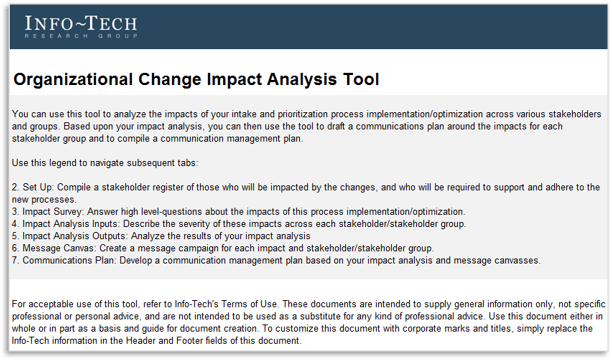
Download the Organizational Change Impact Analysis Tool
3.2.3 Assess the current state of your project environment
15 minutes|
The “2. Set Up” tab of the Impact Tool is where you enter project-specific data pertaining to the change initiative. The inputs on this tab are used to auto-populate fields and drop-down menus on subsequent tabs of the analysis. Document the stakeholders (by individual or group) associated with the project who will be subject to the impacts. You are allowed up to 15 entries. Try to make this list comprehensive. Missing any key stakeholders will threaten the value of this activity as a whole. If you find that you have more than 15 individual stakeholders, you can group individuals into stakeholder groups. |
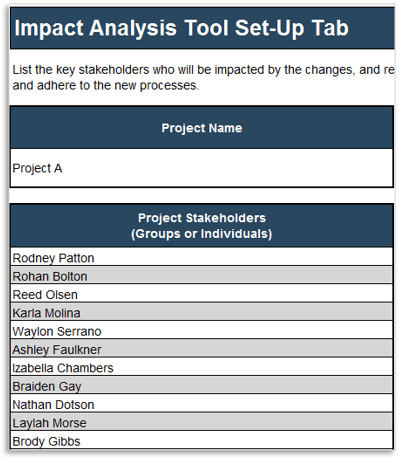
|
Keep in mind…An impact analysis is not a stakeholder management exercise. Impact assessments cover:
Stakeholder management covers:
We will cover the latter in the next step. |
3.2.4 Determine the relevant considerations for analyzing the change impacts
15-30 minutes|
Use the survey on tab 3 of the Impact Analysis Tool to determine the dimensions of change that are relevant. The impact analysis is fueled by the 13-question survey on tab 3 of the tool. This survey addresses a comprehensive assortment of change dimensions, ranging from customer-facing considerations to employee concerns, to resourcing, logistical, and technological questions. Once you have determined the dimensions that are impacted by the change, you can go on to assess how individual stakeholders and stakeholder groups are affected by the change. |
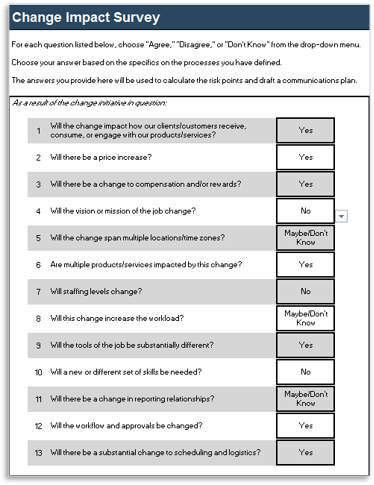
Screenshot of tab “3. Impact Survey,” showing the 13-question survey that drives the impact analysis. Ideally, the survey should be performed by a group of project stakeholders together. Use the drop-down menus in column K to record your responses. |
Impacts will be felt differently by different stakeholders and stakeholder groups
As you assess change impacts, keep in mind that no impact will be felt the same across the organization. Depth of impact can vary depending on the frequency (will the impact be felt daily, weekly, monthly?), the actions necessitated by it (e.g. will it change the way the job is done or is it simply a minor process tweak?), and the anticipated response of the stakeholder (support, resistance, indifference?).
Use the Organizational Change Depth Scale below to help visualize various depths of impact. The deeper the impact, the tougher the job of managing change will be.
Procedural |
Behavioral |
Interpersonal |
Vocational |
Cultural |
| Procedural change involves changes to explicit procedures, rules, policies, processes, etc. | Behavioral change is similar to procedural change, but goes deeper to involve the changing tacit or unconscious habits. | Interpersonal change goes beyond behavioral change to involve changing relationships, teams, locations, reporting structures, and other social interactions. | Vocational change requires acquiring new knowledge and skills and accepting the loss or decline in the value or relevance of previously acquired knowledge and skills. | Cultural change goes beyond interpersonal and vocational change to involve changing personal values, social norms, and assumptions about the meaning of good vs. bad or right vs. wrong. |
| Example: providing sales reps with mobile access to the CRM application to let them update records from the field. | Example: requiring sales reps to use tablets equipped with a custom mobile application for placing orders from the field. | Example: migrating sales reps to work 100% remotely. | Example: migrating technical support staff to field service and sales support roles. | Example: changing the operating model to a more service-based value proposition or focus. |
3.2.5 Determine the depth of each impact for each stakeholder group
1-3 hoursTab “4. Impact Analysis” of the Analysis Tool contains the meat of the impact analysis activity.
- The “Impact Analysis” tab is made up of 13 change impact tables (see next slide for a screenshot of one of these tables).
- You may not need to use all 13 tables. The number of tables you use coincides with the number of “yes” responses you gave in the previous tab.
- If you do not need all 13 impact tables (i.e. if you do not answer “yes” to all thirteen questions in tab 2) the unused/unnecessary tables will not auto-populate.
- Use one table per change impact. Each of your “yes” responses from tab 3 will auto-populate at the top of each change impact table. You should go through each of your “yes” responses in turn.
- Analyze how each impact will affect each stakeholder or stakeholder group touched by the project.
- Column B in each table will auto-populate with the stakeholder groups from the Set-Up tab.
- Use the drop-down menus in columns C, D, and E to rate the frequency of each impact, the actions necessitated by each impact, and the anticipated response of each stakeholder group.
- Each of the options in these drop-down menus is tied to a ranking table that informs the ratings on the two subsequent tabs.
- If warranted, you can use the “Comments” cells in column F to note the specifics of each impact for each stakeholder/group.
See the next slide for an accompanying screenshot of a change impact table from tab 4 of the Analysis Tool.
Screenshot of “Impact Analysis” tab
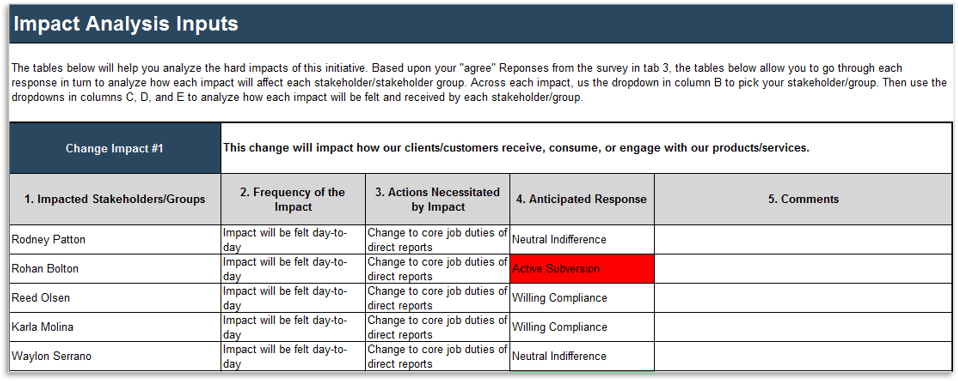
The stakeholder groups entered on the Set Up tab will auto-populate in column B of each table.
Your “yes” responses from the survey tab will auto-populate in the cells to the right of the “Change Impact” cells.
Use the drop-down menus in this column to select how often the impact will be felt for each group (e.g. daily, weekly, periodically, one time, or never).
“Actions” include “change to core job duties,” “change to how time is spent,” “confirm awareness of change,” etc.
Use the drop-down menus to hypothesize what the stakeholder response might be. For the purpose of this impact analysis, a guess is fine. A more detailed communication plan can be created later.
Review your overall impact rating to help assess the likelihood of change adoption
Use the “Overall Impact Rating” on tab 5 to help right-size your OCM efforts.
Based upon your assessment of each individual impact, the Analysis Tool will provide you with an “Overall Impact Rating” in tab 5.
- This rating is an aggregate of each of the individual change impact tables used during the analysis and the rankings assigned to each stakeholder group across the frequency, required actions, and anticipated response columns.
| Projects in the red zone should have maximum change governance, applying a full suite of OCM tools and templates as well as revisiting the impact analysis exercise regularly to help monitor progress.
Increased communication and training efforts, as well as cross-functional partnerships, will also be key for success. |
Projects in the yellow zone also require a high level of change governance.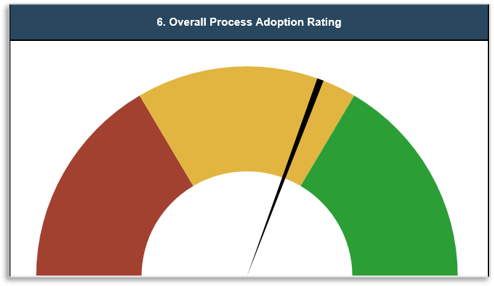
|
To free up resources for those OCM initiatives that require more discipline, projects in the green zone can ease up in their OCM efforts somewhat. With a high likelihood of adoption as is, stakeholder engagement and communication efforts can be minimized somewhat for these projects, so long as the PMO is in regular contact with key stakeholders. |
Use the other outputs on tab 5 to help structure your OCM efforts
In addition to the overall impact rating, tab 5 has other outputs that will help you assess specific impacts and how the overall change will be received by stakeholders.
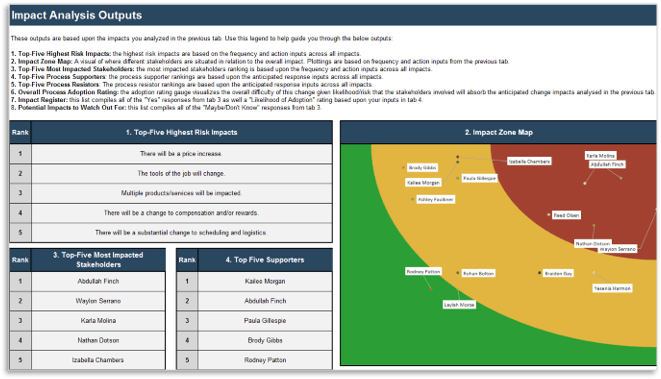
This table displays the highest risk impacts based on frequency and action inputs on tab 4.
Here you’ll find the stakeholders, ranked again based on frequency and action, who will be most impacted by the proposed changes.
These are the five stakeholders most likely to support changes, based on the Anticipated Response column on tab 4.
The stakeholder groups entered on the Set Up tab will auto-populate in column B of each table.
In addition to these outputs, this tab also lists top five change resistors and has an impact register and list of potential impacts to watch out for (i.e. your “maybe” responses from tab 3).
Establish Baseline Metrics
Baseline metrics will be improved through:
- A strong PMO is one than can link performance to the overall goals of the organization.
- Use these examples of KPIs to measure success.
| Metric | KPI |
| Portfolio Performance | Return on Investment (ROI) for projects and programs
Alignment of spend with objectives Resource Utilization Rate (hours allocated to projects actual vs. allocation) Customer/Stakeholder Satisfaction # of strategic projects approved vs. completed |
| Project/Program Performance | % of completed projects (planned vs. actual)
% of projects completed on time (based on original due date) % of projects completed on budget % of projects delivering their expected business outcomes Actual delivery of benefits vs. planned benefits % of customer satisfaction Project manager satisfaction rating |
| PMO | % of approved IT initiatives that measure benefit achievement upon completion
% of IT initiatives with direct alignment to organizational strategic direction |
Summary of Accomplishment
Problem Solved
Knowledge Gained
- PMO Options and “Best Practices”
- PMO Types
- Key PMO Functions/Services
The PMO staffing model that you use will depend on many different factors. It is in your hands to create and define what your staffing needs are for your organization.
The success of your PMO is linked to the plan you create before executing on it.
Processes Optimized
- Establishing organizational need.
- Getting situational awareness to build a solid foundation for the PMO.
- Identifying organizational design and establishing PMO structure and staffing needs.
- Creating an actionable roadmap.
If you would like additional support, have our analysts guide you through other phases as part of an Info-Tech workshop.
Contact your account representative for more information.
workshops@infotech.com 1-888-670-8889
Summary of Accomplishment
Problem Solved
Deliverables Completed
- PMO Role Development Tool
- Initial PMO Mandate
- PMO Job Description Builder Workbook
- PMO job descriptions
- PMO Strategic Plan
- Organizational Change Impact Analysis Tool
If you would like additional support, have our analysts guide you through other phases as part of an Info-Tech workshop.
Contact your account representative for more information.
workshops@infotech.com 1-888-670-8889
Additional Support
If you would like additional support, have our analysts guide you through other phases as part of an Info-Tech workshop.

Contact your account representative for more information.
workshops@infotech.com 1-888-670-8889
To accelerate this project, engage your IT team in an Info-Tech workshop with an Info-Tech analyst team.
Info-Tech analysts will join you and your team at your location or welcome you to Info-Tech’s historic Toronto office to participate in an innovative onsite workshop.
The following are sample activities that will be conducted by Info-Tech analysts with your team:
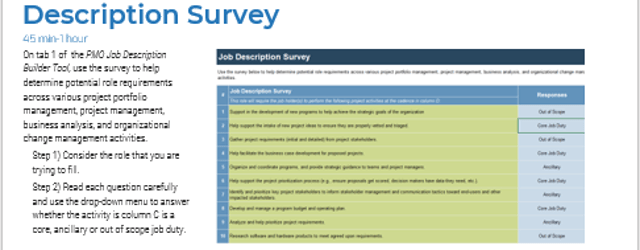
Job Description Survey Use the survey to help determine potential role requirements across various project portfolio management, project management, business analysis, and organizational change management activities. |
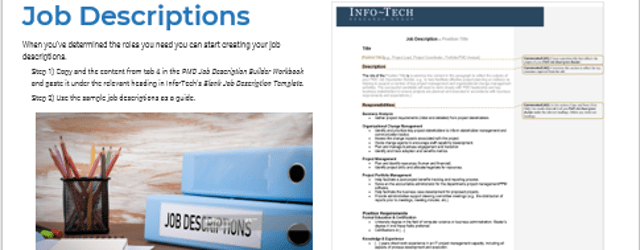
Create Your Job Descriptions Use the job descriptions as a guide when creating your own job descriptions based on the outputs from the tool. |
Related Info-Tech Research

|
Develop a Project Portfolio Management Strategy
Time is money; spend it wisely. |

|
Establish Realistic IT Resource Management Practices
Holistically balance IT supply and demand to avoid overallocation. |

|
Tailor Project Management Processes to Fit Your Projects
Spend less time managing processes and more time delivering results. |
Related Info-Tech Research

|
Optimize IT Project Intake, Approval, and Prioritization
Decide which IT projects to approve and when to start them. |

|
Master Organizational Change Management Practices
PMOs, if you don’t know who is responsible for org change, it’s you. |

|
Set a Strategic Course of Action for the PMO in 100 Days
Use your first 100 days as PMO leader to define a mandate for long-term success. |
Bibliography
Alexander, Moira. “How to Develop a PMO Strategic Plan.” CIO, 11 July 2018. Web.
Barlow, Gina, Andrew Tubb, and Grant Riley. “Driving Business Performance. Project Management Survey 2017.” KPMG, 2017. Accessed 11 Jan. 2022.
Brennan, M. V., and G. Heerkens. “How we went from zero project management to PMO implementation—a real life story.” Paper presented at PMI® Global Congress 2009—North America, Orlando, FL. Project Management Institute, 13 October 2009. Web.
Casey, W., and W. Peck. “Choosing the right PMO setup.” PM Network, vol. 15, no. 2, 2001, pp. 40-47. Web.
“COBIT 2019 Framework Governance and Management Objectives.” ISACA, 2019. PDF.
Crawford, J. K. “Staffing your strategic project office: seven keys to success.” Paper presented at Project Management Institute Annual Seminars & Symposium, San Antonio, TX. Project Management Institute, 2002. Web.
Davis, Stanley M., and Paul R. Lawrence. “Problems of Matrix Organizations.” Harvard Business Review, May 1978. Web.
Dow, William D. “Chapter 6: The Tactical Guide for Building a PMO.” Dow Publishing, 2012. PDF.
Giraudo, L., and E. Monaldi. “PMO evolution: from the origin to the future.” Paper presented at PMI® Global Congress 2015—EMEA, London, England. Project Management Institute, 11 May 2015. Web.
Greengard, S. “No PMO? Know when you need one.” PM Network, vol. 27, no. 12, 2013, pp. 44-49. Web.
Hobbs, J. B., and M. Aubry. “What research is telling us about PMOs.” Paper presented at PMI® Global Congress 2009—EMEA, Amsterdam, North Holland, The Netherlands. Project Management Institute, May 2009. Web.
Jordan, Andy. “Staffing the Strategic PMO.” ProjectManagement.com, 24 October 2016. Web.
Lang, Greg. “5 Questions to Answer When Building a Roadmap.” LinkedIn, 2 October 2016. Accessed 15 Apr. 2021.
Manello, Carl. “Establish a PMO Roadmap.” LinkedIn, 10 February 2021. Accessed 29 Mar. 2021.
Martin, Ken. “5 Steps to Set Up a Successful Project Management Office.” BrightWork, 9 July 2018. Accessed 29 Mar. 2021.
Miller, Jen A. “What Is a Project Management Office (PMO) and Do You Need One?” CIO, 19 October 2017. Accessed 16 Apr. 2021.
Needs, Ian. “Why PMOs Fail: 5 Shocking PMO Statistics.” KeyedIn, 6 January 2014. Web.
Ovans, Andrea. “Overcoming the Peter Principle.” Harvard Business Review, 22 December 2014. Web.
PMI®. “A Guide to the Project Management Body of Knowledge.” 6th Ed. Project Management Institute, 2017.
PMI®. “Ahead of the Curve: Forging a Future-Focused Culture.” Pulse of the Profession. Project Management Institute, 11 February 2020. Accessed 21 April 2021.
PMI®. “Project Management: Job Growth and Talent Gap.” Project Management Institute, 2017. Web.
PMI®. “Pulse of the Profession: Success in Disruptive Times.” Project Management Institute, 2018. Web.
PMI®.“The Project Management Office: In Sync with Strategy.” Project Management Institute, March 2012. Web.
“Project Management Organizational Structures.” PM4Dev, 2016. Web.
Rincon, I. “Building a PMO from the ground up: Three stories, one result.” Paper presented at PMI® Global Congress 2014—North America, Phoenix, AZ. Project Management Institute, 26 October 2014. Web.
Roseke, Bernie. “The 4 Types of Project Organizational Structure.” ProjectEngineer, 16 August 2019. Web.
Sexton, Peter. “Project Delivery Performance: AIPM and KPMG Project Management Survey 2020 - KPMG Australia.” KPMG, 9 November 2020. Web.
The Change Management Office (CMO). Prosci, n.d. Accessed 7 July 2021.
“The New Face of Strategic Planning.” Project Smart, 27 March 2009. Accessed 29 Mar. 2021.
“The State of Project Management Annual Survey.” Wellington PPM Intelligence, 2018. Web.
“The State of the Project Management Office : Enabling Strategy Execution Excellence.” PM Solutions Research, 2016. Web.
Wagner, Rodd. “New Evidence The Peter Principle Is Real - And What To Do About It.” Forbes, 10 April 2018. Accessed 14 Apr. 2021.
Wright, David. “Developing Your PMO Roadmap.” Paper presented at PMI® Global Congress 2012—North America, Vancouver, British Columbia, Canada. Project Management Institute, 2012. Accessed 29 March 2021.
Buying Options
Prepare an Actionable Roadmap for Your PMO
Client rating
Cost Savings
Days Saved
IT Risk Management · IT Leadership & Strategy implementation · Operational Management · Service Delivery · Organizational Management · Process Improvements · ITIL, CORM, Agile · Cost Control · Business Process Analysis · Technology Development · Project Implementation · International Coordination · In & Outsourcing · Customer Care · Multilingual: Dutch, English, French, German, Japanese · Entrepreneur
Tymans Group is a brand by Gert Taeymans BV
Gert Taeymans bv
Europe: Koning Albertstraat 136, 2070 Burcht, Belgium — VAT No: BE0685.974.694 — phone: +32 (0) 468.142.754
USA: 4023 KENNETT PIKE, SUITE 751, GREENVILLE, DE 19807 — Phone: 1-917-473-8669
Copyright 2017-2022 Gert Taeymans BV